LINKSYS WRT54G3G Wireless-G Router for Mobile Broadband User Manual Book
LINKSYS LLC Wireless-G Router for Mobile Broadband Book
LINKSYS >
Contents
- 1. Users manual 1 of 3
- 2. Users manual 2 of 3
- 3. Users manual 3 of 3
- 4. Users manual Web info
Users manual 1 of 3
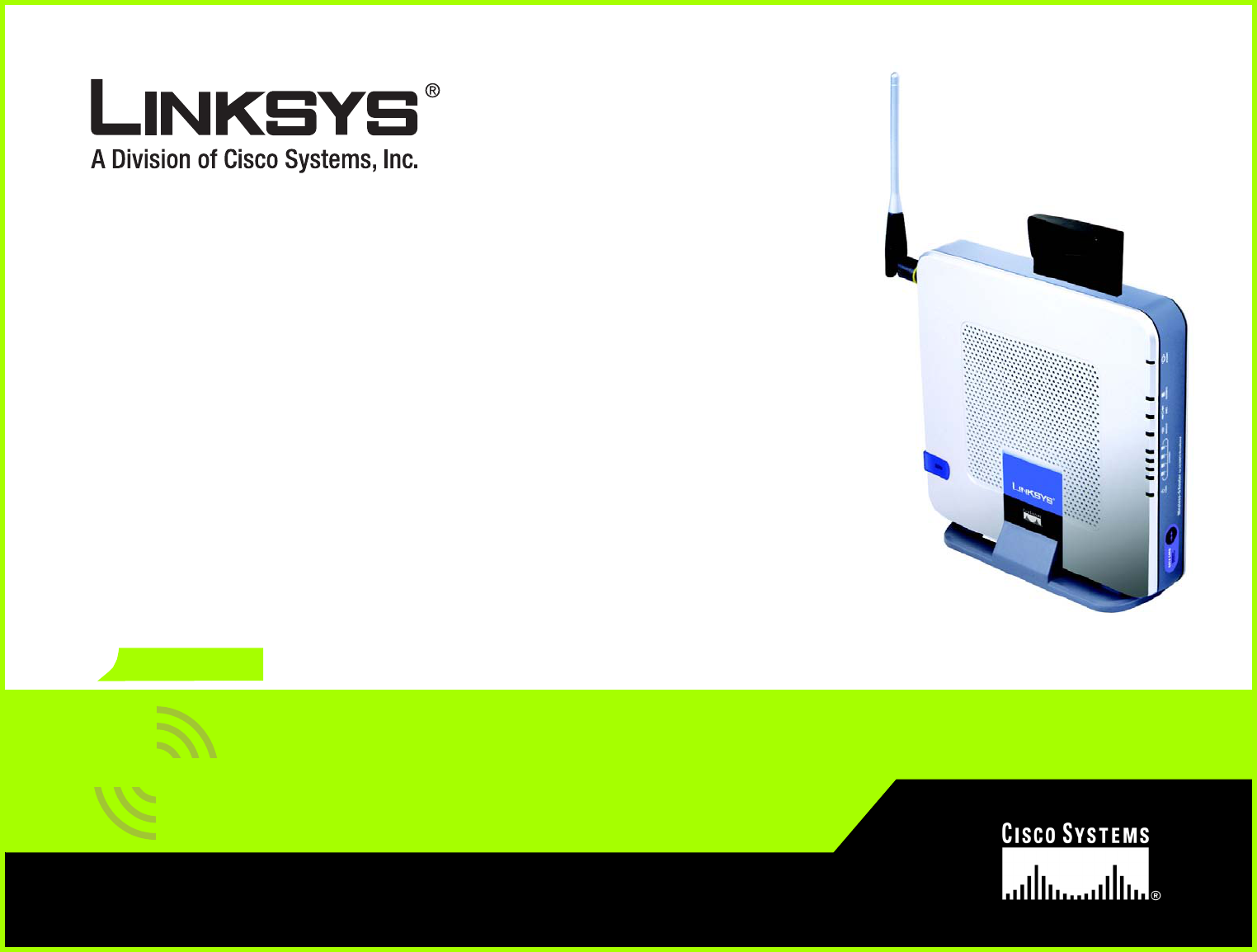
Model No.
Router for Mobile Broadband
Wireless-G
WRT54G3G-ST
User Guide
WIRELESS
GHz
802.11g
2.4

Wireless-G Router for Mobile Broadband
Copyright and Trademarks
Specifications are subject to change without notice. Linksys is a registered trademark or trademark of Cisco
Systems, Inc. and/or its affiliates in the U.S. and certain other countries. Copyright © 2006 Cisco Systems, Inc. All
rights reserved. Other brands and product names are trademarks or registered trademarks of their respective
holders.
How to Use This User Guide
This User Guide has been designed to make understanding networking with the Wireless-G Router for Mobile
Broadband easier than ever. Look for the following items when reading this User Guide:
In addition to these symbols, there are definitions for technical terms that are presented like this:
Also, each figure (diagram, screenshot, or other image) is provided with a figure number and description, like
this:
Figure numbers and descriptions can also be found in the “List of Figures” section in the “Table of Contents”.
This exclamation point means there is a caution or warning and is
something that could damage your property or the Wireless-G Router
for Mobile Broadband.
This checkmark means there is a note of interest and is something
you should pay special attention to while using the Wireless-G Router
for Wireless Broadband.
This question mark provides you with a reminder about something
you might need to do while using the Wireless-G Router for Mobile
Broadband.
word: definition.
Figure 0-1: Sample Figure Description
WRT54G3G-ST-UG 60622NC BW

Wireless-G Router for Mobile Broadband
Table of Contents
Chapter 1: Introduction 1
Welcome 1
What’s in this User Guide? 2
Chapter 2: Planning Your Wireless Network 4
Network Topology 4
Ad-Hoc versus Infrastructure Mode 4
Network Layout 4
Chapter 3: Getting to Know the Wireless-G Router for Mobile Broadband 6
The Router’s Ports 6
The Router’s LEDs 7
The Router’s Data Card Slot 8
Chapter 4: Connecting the Wireless-G Router for Mobile Broadband 9
Overview 9
Hardware Installation for Use of the Mobile Broadband Service Only 9
Hardware Installation for Connection to Your Broadband Modem 11
Hardware Installation for Connection to Another Router 13
Placement Options 15
Chapter 5: Setting up the Wireless-G Router for Mobile Broadband Service 17
Overview 17
Before You Begin 17
Using the Setup Wizard 18
Chapter 6: Setting up the Wireless-G Router for Broadband WAN Service Only 27
Overview 27
Before You Begin 27
Using the Setup Wizard 27
Chapter 7: Setting up the Wireless-G Router for Broadband WAN
and Mobile Broadband Service 39
Overview 39
Before You Begin 39
Using the Setup Wizard 40

Wireless-G Router for Mobile Broadband
Chapter 8: Configuring the Wireless-G Router for Mobile Broadband 53
Overview 53
The Setup Tab - Basic Setup 54
The Setup Tab - Mobile Network 59
The Setup Tab - DDNS 60
The Setup Tab - MAC Address Clone 61
The Setup Tab - Advanced Routing 62
The Wireless Tab - Basic Wireless Settings 63
The Wireless Tab - Wireless Security 64
The Wireless Tab - Wireless MAC Filter 67
The Wireless Tab - Advanced Wireless Settings 68
The Security Tab - Firewall 70
The Security Tab - VPN Passthrough 71
The Access Restrictions Tab - Internet Access 71
The Applications and Gaming Tab - Port Range Forward 73
The Applications & Gaming Tab - Port Triggering 74
The Applications and Gaming Tab - DMZ 75
The Applications and Gaming Tab - QoS 75
The Administration Tab - Management 77
The Administration Tab - Log 78
The Administration Tab - Diagnostics 79
The Administration Tab - Factory Defaults 80
The Administration Tab - Firmware Upgrade 80
The Administration Tab - Config Management 80
The Status Tab - Mobile Network 81
The Status Tab - Router 82
The Status Tab - Local Network 83
The Status Tab - Wireless 84
Appendix A: Troubleshooting 85
Common Problems and Solutions 85
Frequently Asked Questions 93
Appendix B: Wireless Security 101
Security Precautions 101
Security Threats Facing Wireless Networks 101
Appendix C: Upgrading Firmware 104

Wireless-G Router for Mobile Broadband
Appendix D: Windows Help 105
Appendix E: Finding the MAC Address and IP Address for Your Ethernet Adapter 106
Windows 98SE or Me Instructions 106
Windows 2000 or XP Instructions 106
For the Router’s Web-based Utility 107
Appendix F: Glossary 108
Appendix G: Specifications 113
Appendix H: Warranty Information 115
Appendix I: Regulatory Information 117
Appendix J: Contact Information 123

Wireless-G Router for Mobile Broadband
List of Figures
Figure 3-1: The Router’s Ports 6
Figure 3-2: The Router’s Front Panel 6
Figure 3-3: The Router’s LEDs 7
Figure 3-4: The Router’s Data Card Slot 8
Figure 4-1: Connect Your Computer 10
Figure 4-2: Connect the Power 10
Figure 4-3: Connect the Broadband Modem 11
Figure 4-4: Connect Your Computer 12
Figure 4-5: Connect the Power 12
Figure 4-6: Diagram for Connection to Another Router 13
Figure 4-7: Connect Another Router 13
Figure 4-8: Connect Your Computer 14
Figure 4-9: Connect the Power 14
Figure 4-10: Stand Attached to the Router 15
Figure 4-11: Measurement between Wall-Mount Slots 16
Figure 5-1: Setup Wizard’s Welcome - Start Wizard Screen 18
Figure 5-2: Select Service Screen 19
Figure 5-3: Insert Mobile Broadband Data Card Screen 19
Figure 5-4: Connect the Router to a Computer Screen 20
Figure 5-5: Connect the Router to a Computer Screen, Continued 20
Figure 5-6: Power on the Router Screen 21
Figure 5-7: Check the Router’s Status Screen 21
Figure 5-8: Set the Router’s Password Screen 22
Figure 5-9: Wireless Settings Screen 22
Figure 5-10: Configure Wireless Security Settings Screen 23
Figure 5-11: Configure Wireless Security Settings - WPA2-PSK Screen 23
Figure 5-12: Configure Wireless Security Settings - WPA-PSK Screen 24
Figure 5-13: Configure Wireless Security Settings - WEP (128-Bit) Screen 24
Figure 5-14: Configure Wireless Security Settings - WEP (64-Bit) Screen 25
Figure 5-15: Warning about Disabled Wireless Security Screen 25
Figure 5-16: Confirm New Settings Screen 26

Wireless-G Router for Mobile Broadband
Figure 5-17: Mobile Broadband Connection Cannot be Established Screen 26
Figure 5-18: Congratulations Screen 26
Figure 6-1: Setup Wizard’s Welcome - Start Wizard Screen 27
Figure 6-2: Select Service Screen 28
Figure 6-3: Disconnect the Modem from the Computer Screen 28
Figure 6-4: Connect the Modem to the Router Screen 29
Figure 6-5: Connect the Router to a Computer Screen 29
Figure 6-6: Connect the Router to a Computer Screen, continued 30
Figure 6-7: Power on the Router Screen 31
Figure 6-8: Check the Router’s Status Screen 31
Figure 6-9: Configure Cable or DHCP Settings Screen 32
Figure 6-10: Configure DSL (PPPoE) Settings Screen 32
Figure 6-11: Enter Static IP Address Settings Screen 33
Figure 6-12: Confirm New Settings Screen 33
Figure 6-13: Set the Router’s Password Screen 34
Figure 6-14: Wireless Settings Screen 34
Figure 6-15: Configure Wireless Security Settings Screen 35
Figure 6-16: Configure Wireless Security Settings - WPA2-PSK Screen 35
Figure 6-17: Configure Wireless Security Settings - WPA-PSK Screen 36
Figure 6-18: Configure Wireless Security Settings - WEP (128-Bit) Screen 36
Figure 6-19: Configure Wireless Security Settings - WEP (64-Bit) Screen 37
Figure 6-20: Confirm New Settings Screen 37
Figure 6-21: Warning about Disabled Wireless Security Screen 38
Figure 6-22: Congratulations Screen 38
Figure 7-1: Setup Wizard’s Welcome - Start Wizard Screen 40
Figure 7-2: Select Service Screen 41
Figure 7-3: Insert Broadband Mobile Data Card Screen 41
Figure 7-4: Disconnect the Modem from the Computer Screen 42
Figure 7-5: Connect the Modem to the Router Screen 42
Figure 7-6: Connect the Router to a Computer Screen 43
Figure 7-7: Connect the Router to a Computer Screen, continued 43
Figure 7-8: Power on the Router Screen 44
Figure 7-9: Check the Router’s Status Screen 44
Figure 7-10: Configure Cable or DHCP Settings Screen 45

Wireless-G Router for Mobile Broadband
Figure 7-11: Configure DSL (PPPoE) Settings Screen 45
Figure 7-12: Enter Static IP Address Settings Screen 46
Figure 7-13: Confirm New Settings Screen 46
Figure 7-14: Set the Router’s Password Screen 47
Figure 7-15: Wireless Settings Screen 47
Figure 7-16: Configure Wireless Security Settings Screen 48
Figure 7-17: Configure Wireless Security Settings - WPA2-PSK Screen 48
Figure 7-18: Configure Wireless Security Settings - WPA-PSK Screen 49
Figure 7-19: Configure Wireless Security Settings - WEP (128-Bit) 49
Figure 7-20: Configure Wireless Security Settings - WEP (64-Bit) 50
Figure 7-21: Configure Wireless Security Settings - WEP (64-Bit) 50
Figure 7-22: Warning about Disabled Wireless Security Screen 51
Figure 7-23: Confirm New Settings 51
Figure 7-24: Mobile Broadband Connection Cannot be Established Screen 52
Figure 7-25: Congratulations Screen 52
Figure 8-1: Password Screen 53
Figure 8-2: Setup Tab - Basic Setup 54
Figure 8-3: DHCP Connection Type 54
Figure 8-4: Static IP Connection Type 55
Figure 8-5: PPPoE Connection Type 55
Figure 8-6: PPTP Connection Type 55
Figure 8-7: L2TP Connection Type 56
Figure 8-8: Optional Settings 56
Figure 8-9: Router IP 57
Figure 8-10: Network Address Server Settings 57
Figure 8-11: Time Setting 58
Figure 8-12: Setup Tab - Mobile Network 59
Figure 8-13: Setup Tab - DDNS (DynDNS.org) 60
Figure 8-14: Setup Tab - DDNS (TZO.org) 60
Figure 8-15: Setup Tab - MAC Address Clone 61
Figure 8-16: Setup Tab - Advanced Routing (Gateway) 62
Figure 8-17: Setup Tab - Advanced Routing (Router) 62
Figure 8-18: Wireless Tab - Basic Wireless Settings 63
Figure 8-19: Wireless Tab - Wireless Security (WPA2 Personal) 64

Wireless-G Router for Mobile Broadband
Figure 8-20: Wireless Tab - Wireless Security (WPA Personal - TKIP) 64
Figure 8-21: Wireless Tab - Wireless Security (WPA Personal - AES) 64
Figure 8-22: Wireless Tab - Wireless Security (WPA2 Enterprise) 65
Figure 8-23: Wireless Tab - Wireless Security (WPA Enterprise - TKIP) 65
Figure 8-24: Wireless Tab - Wireless Security (WPA Enterprise - AES) 65
Figure 8-25: Wireless Tab - Wireless Security (RADIUS) 66
Figure 8-26: Wireless Tab - Wireless Security (WEP) 66
Figure 8-27: Wireless Tab - Wireless MAC Filter 67
Figure 8-28: MAC Address Filter List 67
Figure 8-29: Wireless Tab - Advanced Wireless Settings 68
Figure 8-30: Security Tab - Firewall 70
Figure 8-31: Security Tab - VPN Passthrough 71
Figure 8-32: Access Restrictions Tab - Internet Access 71
Figure 8-33: Internet Policy Summary 72
Figure 8-34: List of PCs 72
Figure 8-35: Port Services 72
Figure 8-36: Applications and Gaming Tab - Port Range Forward 73
Figure 8-37: Applications and Gaming Tab - Port Triggering 74
Figure 8-38: Applications and Gaming Tab - DMZ 75
Figure 8-39: Applications and Gaming Tab - QoS 75
Figure 8-40: Administration Tab - Management 77
Figure 8-41: Administration Tab - Log 78
Figure 8-42: Administration Tab - Diagnostics 79
Figure 8-43: The Ping Test 79
Figure 8-44: The Traceroute Test 79
Figure 8-45: Administration Tab - Factory Defaults 80
Figure 8-46: Administration Tab - Firmware Upgrade 80
Figure 8-47: Administration Tab - Config Management 80
Figure 8-48: Status Tab - Mobile Network 81
Figure 8-49: Status Tab - Router 82
Figure 8-50: Status Tab - Local Network 83
Figure 8-51: Status Tab - Wireless 84
Figure C-1: Upgrade Firmware 104
Figure E-1: IP Configuration Screen 106

Wireless-G Router for Mobile Broadband
Figure E-2: MAC Address/Adapter Address 106
Figure E-3: MAC Address/Physical Address 106
Figure E-4: MAC Address Filter List 107
Figure E-5: MAC Address Clone 107

1
Chapter 1: Introduction
Welcome
Wireless-G Router for Mobile Broadband
Chapter 1: Introduction
Welcome
Thank you for choosing the Linksys Wireless-G Router for Mobile Broadband The Wireless-G Router for
Mobile Broadband will allow you to network wirelessly better than ever, sharing Internet access, files and fun,
easily and securely.
How does the Wireless-G Router for Mobile Broadband do all of this? A router is a device that allows access to an
Internet connection over a network. With the Wireless-G Router for Mobile Broadband, you can access the
Internet through either your mobile broadband service (requires a mobile broadband data card, available
separately), or you can use a cable or DSL modem for broadband service. Plus, this access can be shared over
the four switched ports or via the wireless broadcast at up to 54Mbps for Wireless-G or up to 11Mbps for
Wireless-B.
Use the WPA or WPA2 standard to secure your wireless network while the whole network is protected through a
Stateful Packet Inspection (SPI) firewall and Network Address Translation (NAT) technology. Run the Setup Wizard
and it will guide you through the steps. You can also access the Router’s features through the easy-to-use,
browser-based utility.
But what does all of this mean?
Networks are useful tools for sharing computer resources. You can access one printer from different computers
and access data located on another computer's hard drive. Networks are even used for playing multiplayer video
games. So, networks are not only useful in homes and offices, they can also be fun.
PCs on a wired network create a LAN, or Local Area Network. They are connected with Ethernet cables, which is
why the network is called “wired”.
PCs equipped with wireless cards or adapters can communicate without cumbersome cables. By sharing the
same wireless settings, within their transmission radius, they form a wireless network. This is sometimes called
a WLAN, or Wireless Local Area Network. The Wireless-G Router for Mobile Broadband bridges wireless networks
of both 802.11b and 802.11g standards and wired networks, allowing them to communicate with each other.
With your networks all connected, wired, wireless, and the Internet, you can now share files and Internet
access—and even play games. All the while, the Wireless-G Router for Mobile Broadband protects your networks
from unauthorized and unwelcome users.
lan (local area network): The computers and
networking products that make up the network in
your home or office.
nat (network address translation): NAT technology
translates IP addresses of a local area network to a
different IP address for the Internet.
wpa (wi-fi protected access): a wireless security
protocol using TKIP (Temporal Key Integrity Protocol)
encryption, which can be used in conjunction with a
RADIUS server.
spi (stateful packet inspection) firewall: a technology
that inspects incoming packets of information before
allowing them to enter the network.
firewall: Security measures that protect the
resources of a local network from intruders.
wpa2 (wi-fi protected access2: a wireless security protocol
using TKIP (Temporal Key Integrity Protocol) encryption and
AES (Advanced Encryption System) with dynamic encryption
keys, which can be used in conjunction with a RADIUS server.

2
Chapter 1: Introduction
What’s in this User Guide?
Wireless-G Router for Mobile Broadband
Linksys recommends using the Setup CD-ROM for first-time installation of the Router. If you do not wish to run
the Setup Wizard on the Setup CD-ROM, then use the instructions in this Guide to help you connect the
Wireless-G Router for Mobile Broadband, set it up, and configure it to bridge your different networks. These
instructions should be all you need to get the most out of the Wireless-G Router for Mobile Broadband.
What’s in this User Guide?
This user guide covers the steps for setting up and using the Wireless-G Router for Mobile Broadband.
• Chapter 1: Introduction
This chapter describes the Router’s applications and this User Guide.
• Chapter 2: Planning Your Wireless Network
This chapter describes the basics of wireless networking.
• Chapter 3: Getting to Know the Wireless-G Router for Mobile Broadband
This chapter describes the physical features of the Router.
• Chapter 4: Connecting the Wireless-G Router for Mobile Broadband
This chapter instructs you on how to connect the Router to your network.
• Chapter 5: Setting up the Wireless-G Router for Mobile Broadband Service
This chapter walks you through the steps of the Setup Wizard to configure the Router for Mobile Broadband
service only.
• Chapter 6: Setting up the Wireless-G Router for Broadband WAN Service Only
This chapter walks you through the steps of the Setup Wizard to configure the Router for broadband WAN
service only.
• Chapter 7: Setting up the Wireless-G Router for Broadband WAN and Wireless Broadband Service
This chapter walks you through the steps of the Setup Wizard to configure the Router for broadband WAN and
Wireless Broadband service.
• Chapter 8: Configuring the Wireless-G Router for Mobile Broadband
This chapter explains how to use the Web-based Utility to configure the settings on the Wireless-G Router for
Mobile Broadband.
• Appendix A: Troubleshooting
This appendix describes some problems and solutions, as well as frequently asked questions, regarding
installation and use of the Wireless-G Router for Mobile Broadband.

3
Chapter 1: Introduction
What’s in this User Guide?
Wireless-G Router for Mobile Broadband
• Appendix B: Wireless Security
This appendix explains the risks of wireless networking and some solutions to reduce the risks.
• Appendix C: Upgrading Firmware
This appendix instructs you on how to upgrade the firmware on the Router should you need to do so.
• Appendix D: Windows Help
This appendix describes how you can use Windows Help for instructions about networking, such as installing
the TCP/IP protocol.
• Appendix E: Finding the MAC Address and IP Address for your Ethernet Adapter.
This appendix describes how to find the MAC address for your computer’s Ethernet adapter so you can use
the MAC filtering and/or MAC address cloning feature of the Router.
• Appendix F: Glossary
This appendix gives a brief glossary of terms frequently used in networking.
• Appendix G: Specifications
This appendix provides the technical specifications for the Router.
• Appendix H: Warranty Information
This appendix supplies the warranty information for the Router.
• Appendix I: Regulatory Information
This appendix supplies the regulatory information regarding the Router.
• Appendix J: Contact Information
This appendix provides contact information for a variety of Linksys resources, including Technical Support.

4
Chapter 2: Planning Your Wireless Network
Network Topology
Wireless-G Router for Mobile Broadband
Chapter 2: Planning Your Wireless Network
Network Topology
A wireless local area network (WLAN) is exactly like a regular local area network (LAN), except that each
computer in the WLAN uses a wireless device to connect to the network. Computers in a WLAN share the same
frequency channel and SSID, which is an identification name shared by the wireless devices belonging to the
same wireless network.
Ad-Hoc versus Infrastructure Mode
Unlike wired networks, wireless networks have two different modes in which they may be set up: infrastructure
and ad-hoc. An infrastructure configuration is a WLAN and wired LAN communicating to each other through an
access point. An ad-hoc configuration is wireless-equipped computers communicating directly with each other.
Choosing between these two modes depends on whether or not the wireless network needs to share data or
peripherals with a wired network or not.
If the computers on the wireless network need to be accessible by a wired network or need to share a peripheral,
such as a printer, with the wired network computers, the wireless network should be set up in Infrastructure
mode. The basis of Infrastructure mode centers around a wireless router or an access point, such as the
Wireless-G Router for Mobile Broadband, which serves as the main point of communications in a wireless
network. The Router transmits data to PCs equipped with wireless network adapters, which can roam within a
certain radial range of the Router. You can arrange the Router and multiple access points to work in succession
to extend the roaming range, and you can set up your wireless network to communicate with your Ethernet
hardware as well.
If the wireless network is relatively small and needs to share resources only with the other computers on the
wireless network, then the Ad-Hoc mode can be used. Ad-Hoc mode allows computers equipped with wireless
transmitters and receivers to communicate directly with each other, eliminating the need for a wireless router or
access point. The drawback of this mode is that in Ad-Hoc mode, wireless-equipped computers are not able to
communicate with computers on a wired network. And, of course, communication between the wireless-
equipped computers is limited by the distance and interference directly between them.
Network Layout
The Wireless-G Router for Mobile Broadband has been specifically designed for use with both your 802.11b and
802.11g products. It is compatible with all 802.11g and 802.11b adapters, such as the notebook adapters for your
infrastructure: a wireless network that is bridged
to a wired network via an access point.
ssid (service set identifier): your wireless network’s name.
ad-hoc: a group of wireless devices
communicating directly to each other (peer-to-
peer) without the use of an access point.

5
Chapter 2: Planning Your Wireless Network
Network Layout
Wireless-G Router for Mobile Broadband
laptop computers, PCI adapters for your desktop PCs, and USB adapters when you want to enjoy USB
connectivity. The Router will also communicate with the Wireless PrintServer and Wireless Ethernet Bridges.
When you wish to connect your wireless network with your wired network, you can use the Wireless-G Router for
Mobile Broadband’s four Ethernet LAN ports. To add more ports, any of the Router's LAN ports can be connected
to any of Linksys's switches.
With these, and many other Linksys products, your networking options are limitless. Go to the Linksys website at
www.linksys.com for more information about products that work with the Wireless-G Router for
Mobile Broadband.
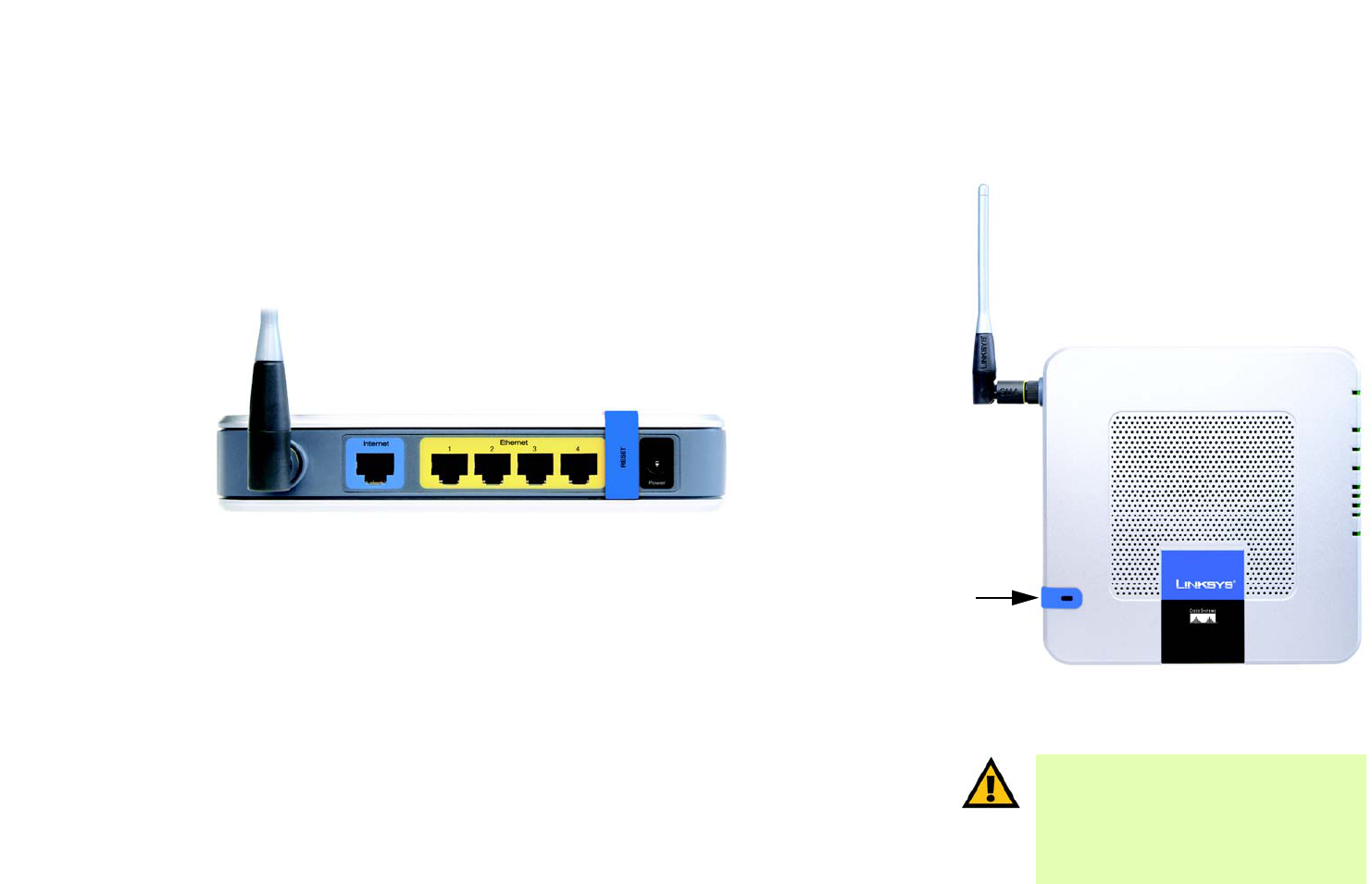
6
Chapter 3: Getting to Know the Wireless-G Router for Mobile Broadband
The Router’s Ports
Wireless-G Router for Mobile Broadband
Chapter 3: Getting to Know the Wireless-G Router for
Mobile Broadband
The Router’s Ports
The Router's ports and Reset button are located on the side panel with the antenna port.
Antenna The antenna port is where you will attach the Router’s antenna.
Internet The Internet port is where you will connect your broadband Internet connection, if you are
using broadband WAN service.
Ethernet
1, 2, 3, 4 These ports (1, 2, 3, 4) connect the Router to your PCs and other Ethernet network devices.
Security Bracket The bracket labeled “RESET” clips onto the Router. It covers the Reset button and the security
slot on the Router’s front panel. You can remove the security bracket to access the Reset
button. To protect the Router from theft, you can attach a lock to the Router using the security
slot and bracket.
Reset Button There are two ways to reset the Router's factory defaults. Either press the Reset button, for
approximately five seconds, or restore the defaults from the Administration tab - Factory
Defaults tab in the Router's Web-based Utility.
Power The Power port is where you will connect the power adapter.
IMPORTANT: Resetting the Router will erase
all of your settings (Internet connection,
wireless security, and other settings) and
replace them with the factory defaults. Do not
reset the Router if you want to retain these
settings.
Figure 3-1: The Router’s Ports
Figure 3-2: The Router’s Front Panel
Security
Bracket

7
Chapter 3: Getting to Know the Wireless-G Router for Mobile Broadband
The Router’s LEDs
Wireless-G Router for Mobile Broadband
The Router’s LEDs
The Router’s LEDs are located on the Router’s other side panel.
Data Card Button This button allows you to connect to and disconnect from the mobile network (you can also
connect and disconnect using the Basic Setup tab of the Router’s Web-based Utility).
POWER Green. The POWER LED lights up and will stay on when the Router is powered on. When the
Router goes through its self-diagnostic mode during every boot-up, this LED will flash. When
the diagnostic is complete, the LED will be solidly lit.
ETHERNET
1, 2, 3, 4 Green. These numbered LEDs, corresponding with the numbered ports on the Router’s back
panel, serve two purposes. If the LED is continuously lit, the Router is successfully connected
to a device through that port. A flashing LED indicates network activity over that port.
DMZ Green. The DMZ LED lights up and will remain lit while the Router uses its DMZ function.
WIRELESS Green. The WIRELESS LED lights up whenever there is a successful wireless connection. If the
LED is flashing, the Router is actively sending or receiving data over the wireless network.
DATA CARD Blue.The DATA CARD LED flashes as the Router connects to the mobile network. It is solidly lit
when the connection is established.
The LED quickly flashes if the Router does not have a connection to the mobile network. A data
card must be inserted into the Router when you press the Data Card Connect/Disconnect
button.
INTERNET Green. The INTERNET LED lights up when a connection is made through the Internet port.
Figure 3-3: The Router’s LEDs

8
Chapter 3: Getting to Know the Wireless-G Router for Mobile Broadband
The Router’s Data Card Slot
Wireless-G Router for Mobile Broadband
The Router’s Data Card Slot
The Router’s Data Card slot is located on the Router’s top panel.
Data Card Slot Insert the mobile broadband data card (available separately) into this slot if the Router will
connect to a mobile broadband service.
Figure 3-4: The Router’s Data Card Slot

9
Chapter 4: Connecting the Wireless-G Router for Mobile Broadband
Overview
Wireless-G Router for Mobile Broadband
Chapter 4: Connecting the Wireless-G Router for Mobile
Broadband
Overview
Most users who are connecting the Router to the Internet for the first time can proceed to the appropriate chapter
about the Setup Wizard and use this chapter as reference on how to connect the hardware. There are three
chapters about the Setup Wizard available. If you want to configure the Router for mobile broadband service only,
go to “Chapter 5: Setting up the Wireless-G Router for Mobile Broadband Service.” If you want to configure the
Router for broadband WAN service only, go to “Chapter 6: Setting up the Wireless-G Router for Broadband WAN
Service Only.” If you want to configure the Router for broadband WAN and mobile broadband service, go to
“Chapter 7: Setting up the Wireless-G Router for Broadband WAN and Mobile Broadband Service.”
This chapter includes three sets of instructions. Follow the instructions for your configuration.
• If the Router will use the mobile broadband service only, follow the instructions in “Hardware Installation for
Use of the Mobile Broadband Service.”
• If the Router will be the only router in your network and you have a broadband modem, follow the instructions
in “Hardware Installation for Connection to Your Broadband Modem.”
• If you want to install the Wireless-G Router for Mobile Broadband behind another router in your network, then
follow the instructions in “Hardware Installation for Connection to Another Router.”
Hardware Installation for Use of the Mobile Broadband Service Only
1. Power down your network devices.
2. Locate an optimum location for the Router. The best place for the Router is usually at the center of your
wireless network, with line of sight to all of your mobile stations.
3. Attach the antenna and fix its direction. Try to place the Router in a position that will best cover your wireless
network. Normally, the higher you place the antenna, the better the performance will be.
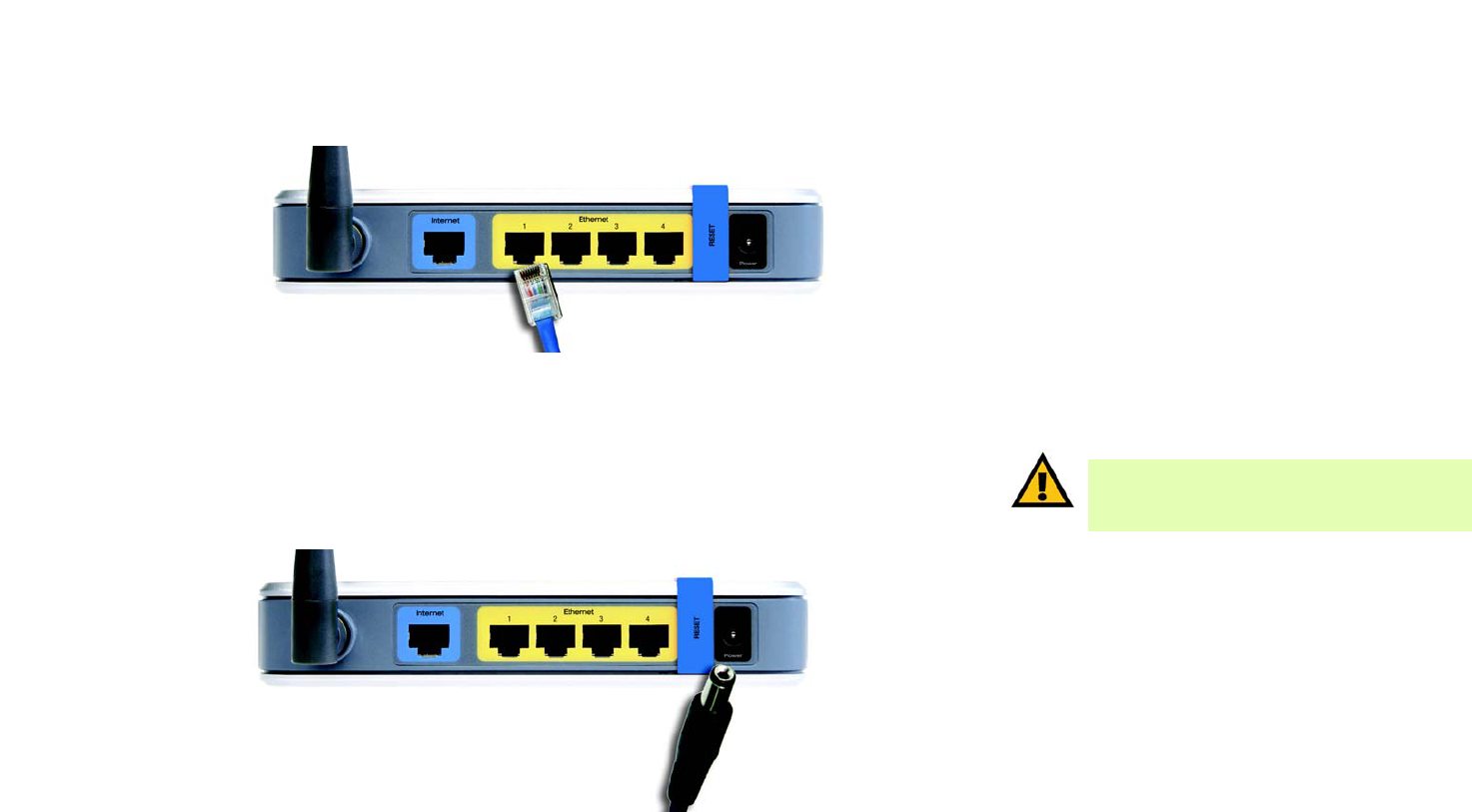
10
Chapter 4: Connecting the Wireless-G Router for Mobile Broadband
Hardware Installation for Use of the Mobile Broadband Service Only
Wireless-G Router for Mobile Broadband
4. Connect your network PCs or Ethernet devices to the Router’s numbered ports using standard Ethernet
network cabling.
5. Connect the power adapter to the Router's Power port, and plug the other end into an electrical outlet. Only
use the power adapter supplied with the Router. Use of a different adapter may result in product damage.
Proceed to the section at the end of this chapter, “Placement Options.”
Figure 4-1: Connect Your Computer
Figure 4-2: Connect the Power
IMPORTANT: Make sure you use the power
adapter that is supplied with the Router. Use of a
different power adapter could damage the Router.
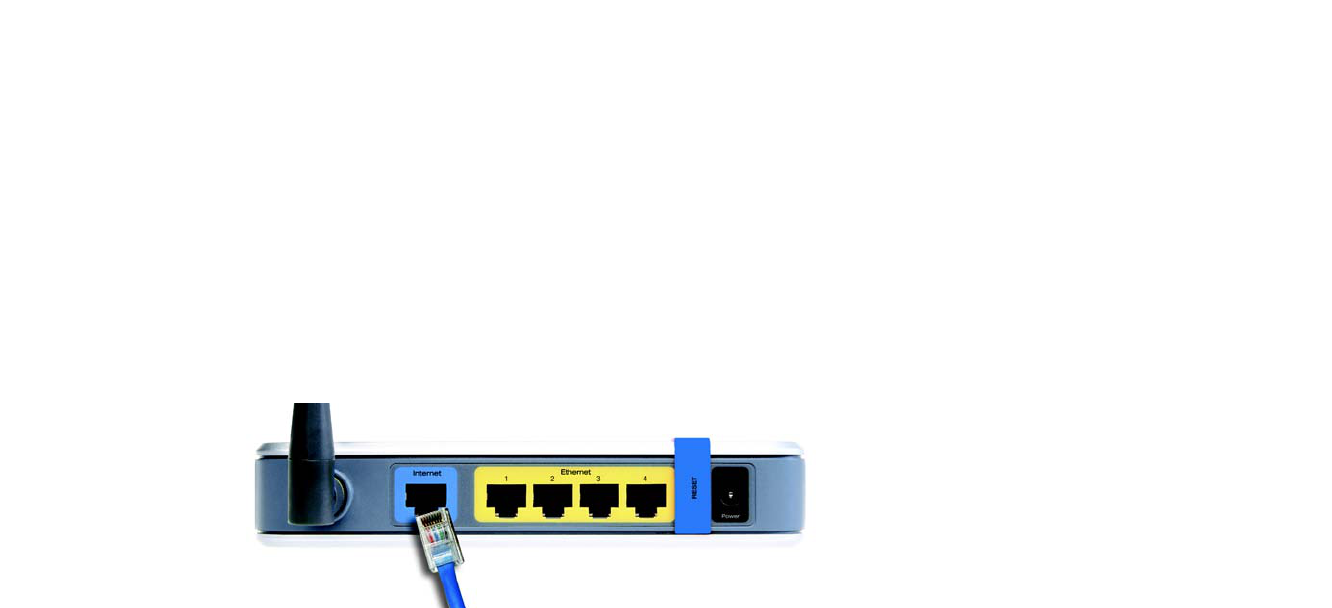
11
Chapter 4: Connecting the Wireless-G Router for Mobile Broadband
Hardware Installation for Connection to Your Broadband Modem
Wireless-G Router for Mobile Broadband
Hardware Installation for Connection to Your Broadband Modem
1. Power down your network devices.
2. Locate an optimum location for the Router. The best place for the Router is usually at the center of your
wireless network, with line of sight to all of your mobile stations.
3. Attach the antenna and fix its direction. Try to place the Router in a position that will best cover your wireless
network. Normally, the higher you place the antenna, the better the performance will be.
4. Connect a standard Ethernet network cable to the Router’s Internet port. Then, connect the other end of the
Ethernet cable to your cable or DSL broadband modem.
Figure 4-3: Connect the Broadband Modem
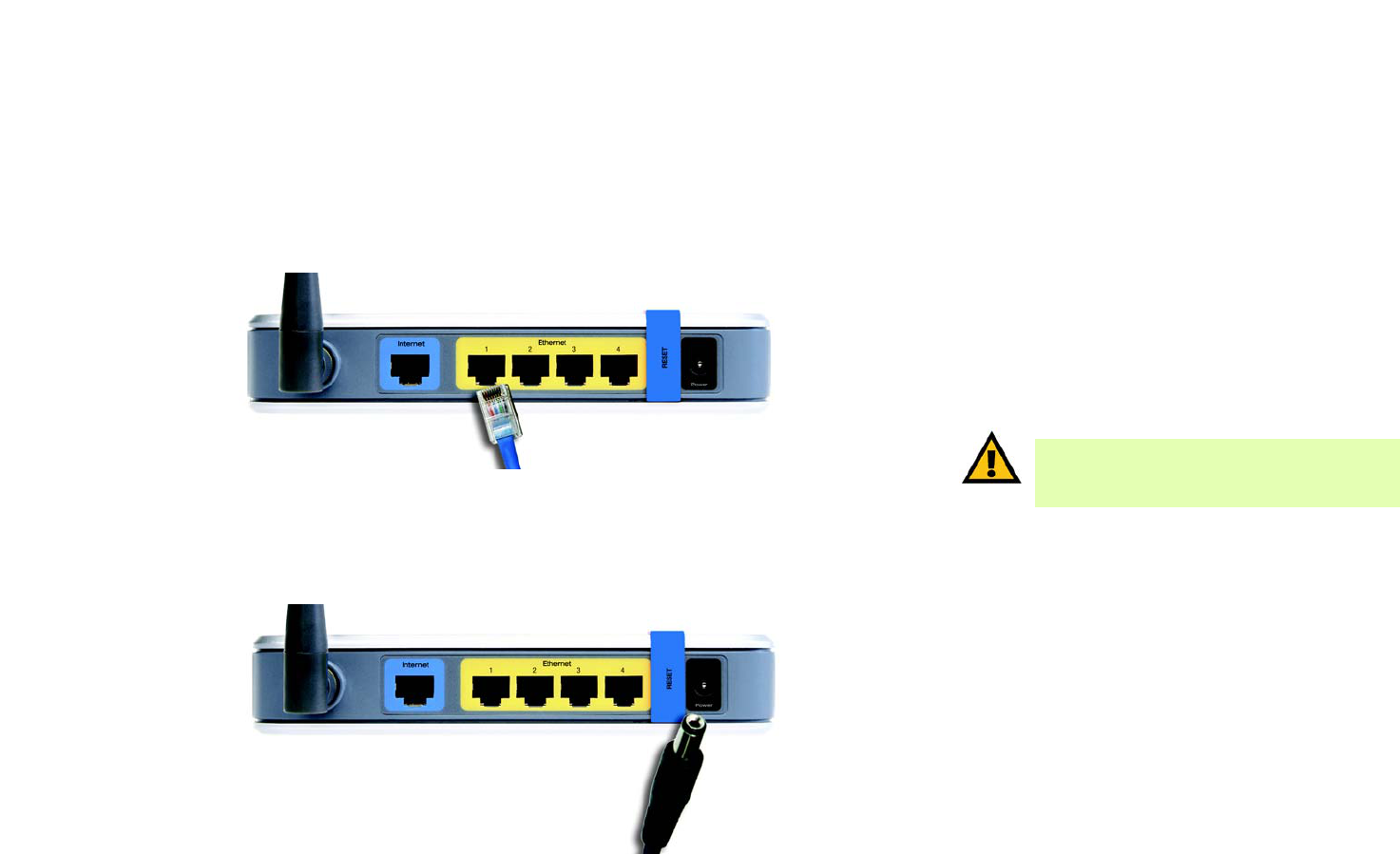
12
Chapter 4: Connecting the Wireless-G Router for Mobile Broadband
Hardware Installation for Connection to Your Broadband Modem
Wireless-G Router for Mobile Broadband
5. Connect your network PCs or Ethernet devices to the Router’s numbered ports using standard Ethernet
network cabling.
6. Connect the power adapter to the Router's Power port, and plug the other end into an electrical outlet. Only
use the power adapter supplied with the Router. Use of a different adapter may result in product damage.
Proceed to the section at the end of this chapter, “Placement Options.”
Figure 4-5: Connect the Power
IMPORTANT: Make sure you use the power
adapter that is supplied with the Router. Use of a
different power adapter could damage the Router.
Figure 4-4: Connect Your Computer
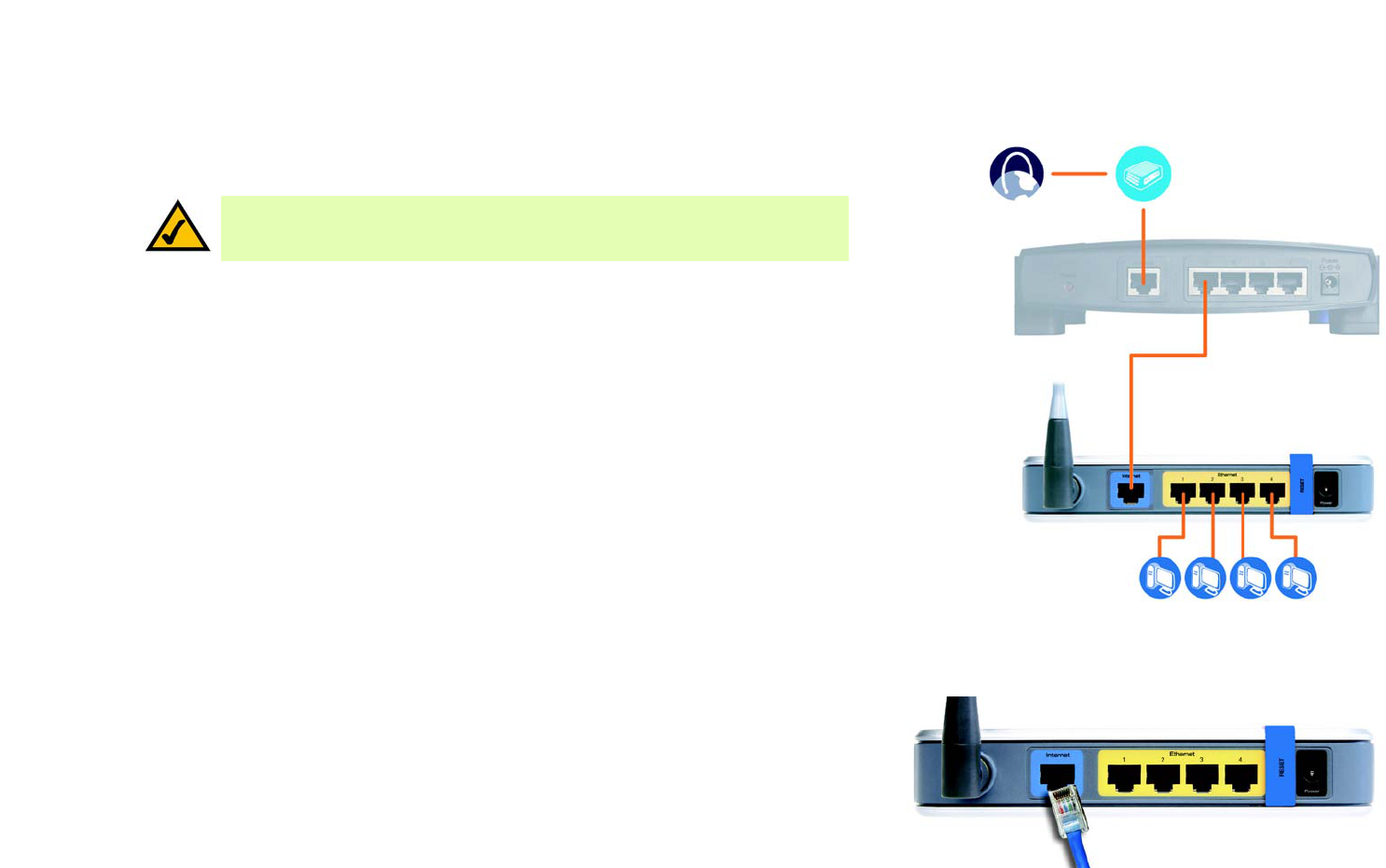
13
Chapter 4: Connecting the Wireless-G Router for Mobile Broadband
Hardware Installation for Connection to Another Router
Wireless-G Router for Mobile Broadband
Hardware Installation for Connection to Another Router
Before you install the Wireless-G Router for Mobile Broadband, you will need to check if the default IP address of
the other Router is 192.168.1.1. If so, there will be an IP address conflict with the new Router. Follow the
instructions below to change the default IP address of the existing Router to 192.168.2.1.
First, make sure the Router is NOT connected to your network. Then follow these instructions:
1. To access the other Router’s Web-based Utility, launch Internet Explorer or Netscape Navigator, and enter the
other router’s default IP address in the Address field. Then press Enter.
2. A password request page will appear. Leave the User Name field blank. In the Password field, enter the
password you have set (the default password is admin). Then click the OK button.
3. The first screen that appears will display the Setup tab. In the Network Setup section, there is a setting
called Local IP Address, which is set to 192.168.1.1. Change this to 192.168.2.1.
4. Click the Save Settings button to save your change, and then exit the Web-based Utility.
5. Power down your network devices. Now you will begin the hardware installation of Router.
6. Locate an optimum location for the Router. The best place for the Router is usually at the center of your
wireless network, with line of sight to all of your mobile stations.
7. Attach the antenna and fix its direction. Try to place the Router in a position that will best cover your
wireless network. Normally, the higher you place the antenna, the better the performance will be.
8. Connect a standard Ethernet network cable to the Router’s Internet port. Then, connect the other end of the
Ethernet cable to one of the numbered Ethernet ports on your other router.
Figure 4-6: Diagram for Connection to Another Router
NOTE: Steps 1-4 are instructions for a typical Linksys router; however, if you are using
a non-Linksys router, refer to the other router’s documentation for instructions on how
to change its local IP address to 192.168.2.1.
Internet
Broadband
Modem
Router
Wireless-G Router
for Mobile
Broadband
Multiple PCs
Figure 4-7: Connect Another Router
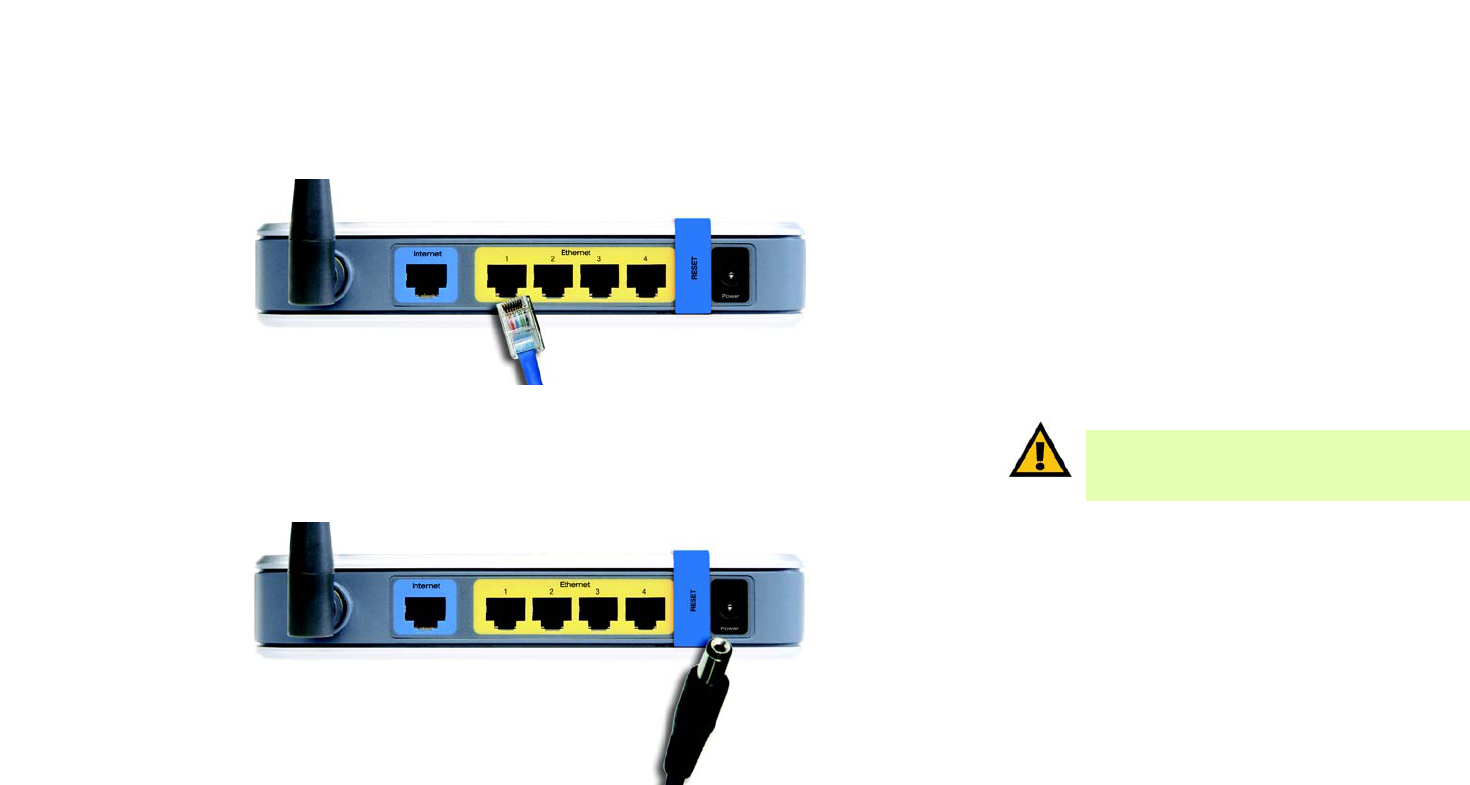
14
Chapter 4: Connecting the Wireless-G Router for Mobile Broadband
Hardware Installation for Connection to Another Router
Wireless-G Router for Mobile Broadband
9. Decide which network computers or Ethernet devices you want to connect to the Router.
Disconnect the selected computers or devices from the other router, and then connect them to the Router’s
numbered ports using standard Ethernet network cabling.
10. Connect the power adapter to the Router's Power port, and plug the other end into an electrical outlet. Only
use the power adapter supplied with the Router. Use of a different adapter may result in product damage.
Proceed to the next section, “Placement Options.”
IMPORTANT: Make sure that you use the power
adapter that is supplied with the Router. Use of a
different power adapter could damage the Router.
Figure 4-9: Connect the Power
Figure 4-8: Connect Your Computer
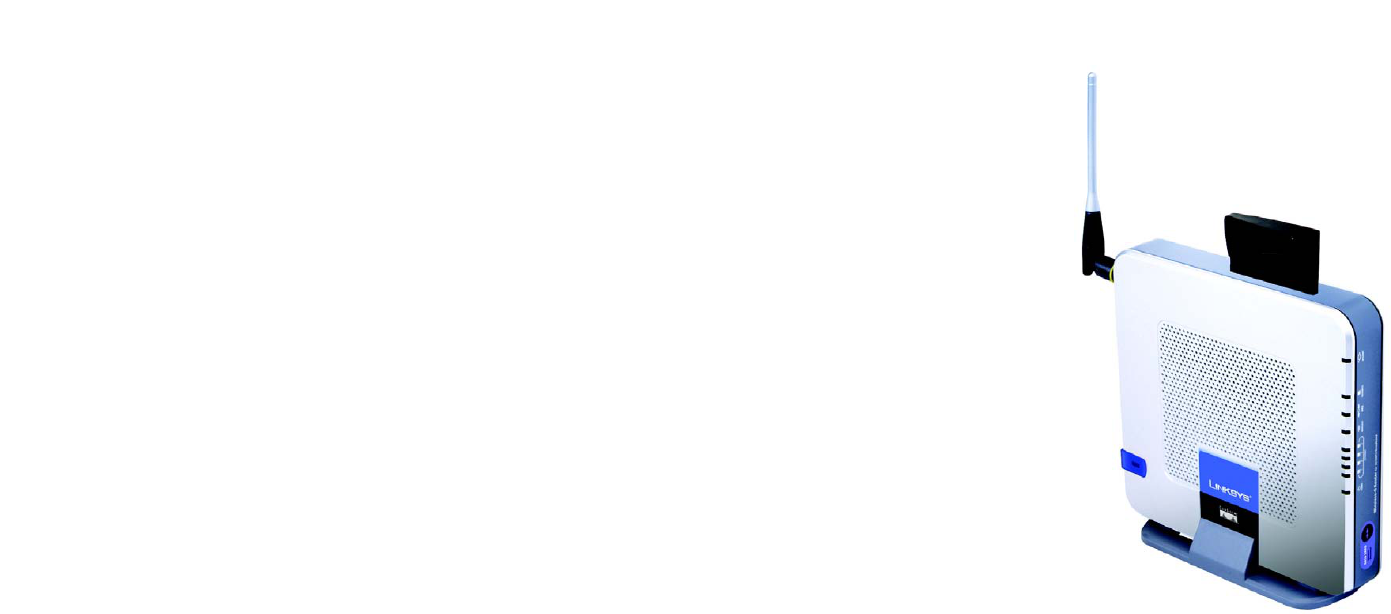
15
Chapter 4: Connecting the Wireless-G Router for Mobile Broadband
Placement Options
Wireless-G Router for Mobile Broadband
Placement Options
There are three ways to place the Router. The first way is to place it horizontally on a surface, so it sits on its four
rubber feet. The second way is to stand the Router vertically on a surface. The third way is to mount it on a wall.
The second and third options are explained in further detail below.
Stand Option
1. Line up the center of the Router’s stand with the center of the Router’s labeled edge.
2. Insert the Router into the stand.
If you want to configure the Router for mobile broadband service only, go to “Chapter 5: Setting up the
Wireless-G Router for Mobile Broadband Service.”
If you want to configure the Router for broadband WAN service only, go to “Chapter 6: Setting up the
Wireless-G Router for Broadband WAN Service Only.”
If you want to configure the Router for broadband WAN and mobile broadband service, go to “Chapter 7:
Setting up the Wireless-G Router for Broadband WAN and Mobile Broadband Service.”
Figure 4-10: Stand Attached to the Router

16
Chapter 4: Connecting the Wireless-G Router for Mobile Broadband
Placement Options
Wireless-G Router for Mobile Broadband
Wall-Mount Option
The Router has four wall-mount slots on its bottom panel. The distance between two adjacent slots is
68 mm (2.68 inches).
Before you begin, make sure you have two screws that are size #4—this indicates a diameter measurement of
2.845 mm (0.112 inches).
1. Determine where you want to mount the Router.
2. Drill two holes into the wall. Make sure adjacent holes are 68 mm (2.68 inches) apart.
3. Insert a screw into each hole, and leave 5 mm (0.2 inches) of its head exposed.
4. Maneuver the Router so the top wall-mount slots line up with the two screws.
5. Place the wall-mount slots over the screws and slide the Router down until the screws fit snugly into the wall-
mount slots.
If you want to configure the Router for mobile broadband service only, go to “Chapter 5: Setting up the
Wireless-G Router for Mobile Broadband Service.”
If you want to configure the Router for broadband WAN service only, go to “Chapter 6: Setting up the
Wireless-G Router for Broadband WAN Service Only.”
If you want to configure the Router for broadband WAN and mobile broadband service, go to “Chapter 7:
Setting up the Wireless-G Router for Broadband WAN and Mobile Broadband Service.”
Figure 4-11: Measurement between Wall-Mount Slots
68 mm
(2,68 inches)

17
Chapter 5: Setting up the Wireless-G Router for Mobile Broadband Service
Overview
Wireless-G Router for Mobile Broadband
Chapter 5: Setting up the Wireless-G Router for Mobile
Broadband Service
Overview
This chapter covers the steps for configuring the Router for mobile broadband service only. If you want to
configure the Router for broadband WAN service only, go to “Chapter 6: Setting up the Wireless-G Router for
Broadband WAN Service Only.” If you want to configure the Router for broadband WAN and mobile broadband
service, go to “Chapter 7: Setting up the Wireless-G Router for Broadband WAN and Mobile Broadband Service.”
Before You Begin
Before you begin, make sure that you have the following:
• your activated Mobile Broadband Data Card
• your Mobile Broadband Data Card Service information.
The information about your Mobile Broadband Data Card was included with your Mobile Broadband Data Card
package. If you do not have this information, contact the mobile broadband service provider’s customer support.
IMPORTANT: If you do NOT have your Mobile Broadband Data Card you cannot configure the
Router for mobile broadband service. However, you can configure the Router for broadband WAN
service; for instructions, proceed to “Chapter 6: Setting up the Wireless-G Router for Broadband
WAN Service Only.”
IMPORTANT: Make sure your Mobile Broadband Data Card is activated before starting the
setup. If you have not already done so, follow the instructions provided in your Card’s
documentation.

18
Chapter 5: Setting up the Wireless-G Router for Mobile Broadband Service
Using the Setup Wizard
Wireless-G Router for Mobile Broadband
Using the Setup Wizard
1. Insert the Setup Wizard CD-ROM into your CD-ROM drive. The Setup Wizard should run automatically, and the
Welcome screen should appear. If it does not, click the Start button and choose Run. In the field that
appears, enter D:\SetupWizard.exe (if “D” is the letter of your CD-ROM drive).
2. On the Welcome screen, click the Click Here to Start button if this is the first time you are running the Setup
Wizard. These are your other choices:
User Guide - Click the User Guide button to open the PDF file of this User Guide.
Exit - Click the Exit button to exit the Setup Wizard.
Figure 5-1: Setup Wizard’s Welcome - Start
Wizard Screen

19
Chapter 5: Setting up the Wireless-G Router for Mobile Broadband Service
Using the Setup Wizard
Wireless-G Router for Mobile Broadband
3. Click the Mobile Broadband Only radio button to configure the Router for mobile broadband service.
4. Make sure the Router is powered off. Insert your mobile broadband data card into the Router’s Data Card Slot
on the top panel of the Router. Then click the Next button.
Figure 5-2: Select Service Screen
Figure 5-3: Insert Mobile Broadband Data Card Screen
NOTE: If you click the Broadband WAN Only radio button to configure the Router for broadband
WAN service only, go to “Chapter 6: Setting up the Wireless-G Router for Broadband WAN
Service Only.” If you click the Broadband WAN and Mobile Broadband radio button to
configure the Router for broadband WAN and mobile broadband service, go to “Chapter 7:
Setting up the Wireless-G Router for Broadband WAN and Mobile Broadband Service.”

20
Chapter 5: Setting up the Wireless-G Router for Mobile Broadband Service
Using the Setup Wizard
Wireless-G Router for Mobile Broadband
5. Connect the included Ethernet network cable to the Ethernet network port of your computer. (This cable is
color-coded yellow to match the yellow Ethernet ports on the Router.)
Click the Next button.
6. Connect the other end of the cable to one of the Ethernet ports labeled 1-4 on the side panel of the Router.
If necessary, connect any additional computers or other devices to the Router.
Click the Next button.
Figure 5-4: Connect the Router to a Computer Screen
Figure 5-5: Connect the Router to a Computer Screen,
Continued

21
Chapter 5: Setting up the Wireless-G Router for Mobile Broadband Service
Using the Setup Wizard
Wireless-G Router for Mobile Broadband
7. Connect the power adapter to the Router’s Power port. Plug the other end into an electrical outlet.
Click the Next button.
8. Make sure the LEDs on the Router light up. The Power LED will flash for a few seconds while the Router goes
through its self-diagnostics test. This LED will be solidly lit when the self-test is complete. If it does not stop
flashing, refer to “Appendix A: Troubleshooting.”
Click the Next button.
Figure 5-6: Power on the Router Screen
Figure 5-7: Check the Router’s Status Screen

22
Chapter 5: Setting up the Wireless-G Router for Mobile Broadband Service
Using the Setup Wizard
Wireless-G Router for Mobile Broadband
9. The Router provides a Web-based Utility you can use for configuring the Router from any networked PC.
Password - Enter a password that will control access to the Utility.
Confirm - Then enter it again in the Confirm field.
Click the Next button.
10. The Setup Wizard will ask you to enter the settings for your wireless network.
Wireless Network Name - In the Wireless Network Name field, enter the name of your wireless network,
also called the SSID. The name must be identical for all devices in the network. The default setting is linksys
(all lowercase).
Channel - Select the operating channel for your wireless network. All of your wireless devices will use this
channel to communicate.
Click the Next button.
Figure 5-8: Set the Router’s Password Screen
Figure 5-9: Wireless Settings Screen
IMPORTANT: If you do NOT have your mobile broadband data card, you cannot configure the
Router for mobile broadband service. You have two choices. To continue with the Setup Wizard
to configure the wireless settings, proceed to step 14, or to configure the Router for broadband
WAN service only, proceed to “Chapter 6: Setting up the Wireless-G Router for Broadband WAN
Service Only” for instructions.
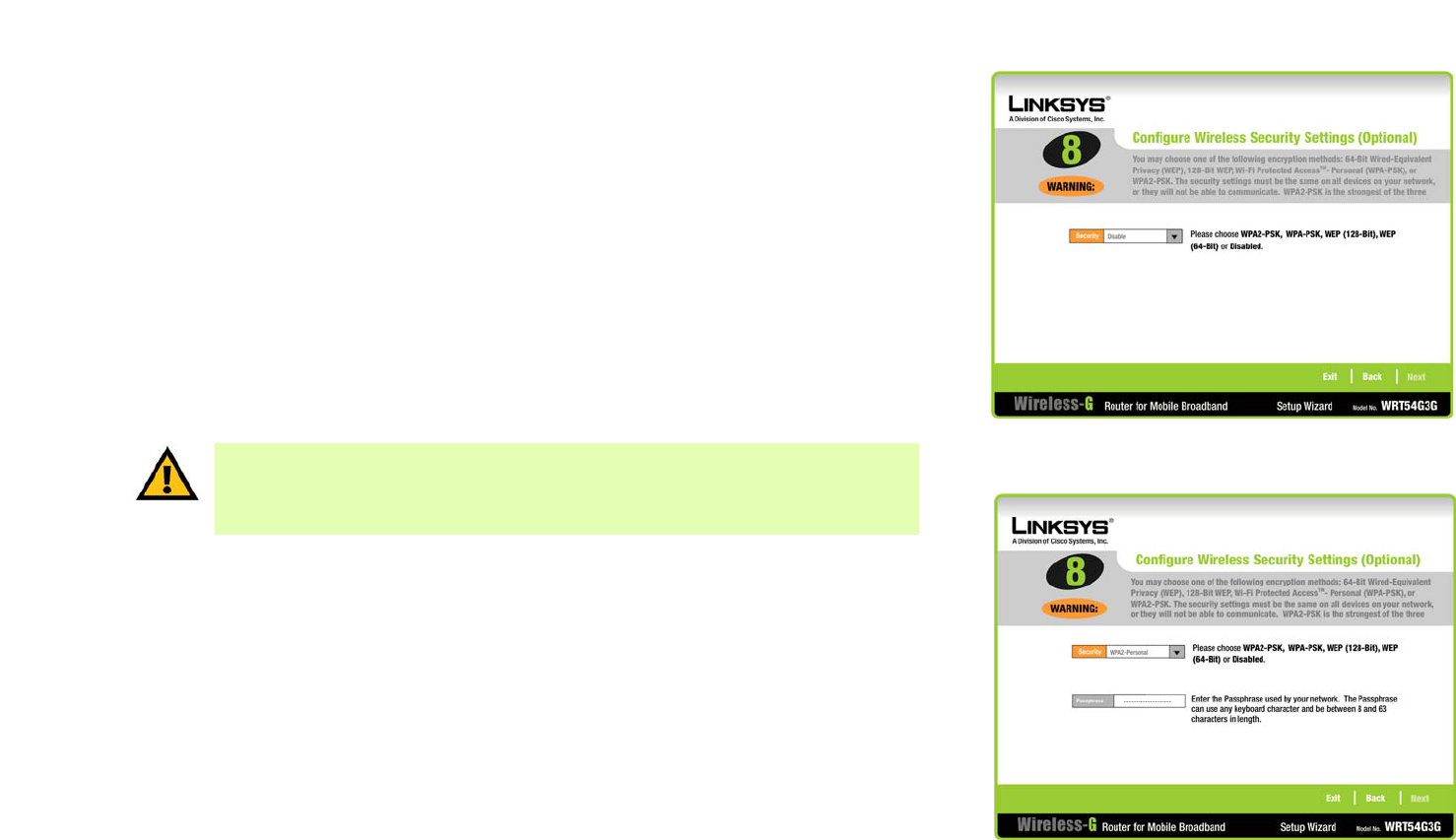
23
Chapter 5: Setting up the Wireless-G Router for Mobile Broadband Service
Using the Setup Wizard
Wireless-G Router for Mobile Broadband
11. Select the method of security you want to use: WPA2-PSK, WPA-PSK, WEP (128-Bit), or WEP (64-Bit). WPA
stands for Wi-Fi Protected Access, and WEP stands for Wired Equivalent Privacy. WPA is a stronger security
method than WEP. WPA2 is the strongest security method. Proceed to the appropriate section for your security
method.
If you want to use WPA-Enterprise (also called WPA-RADIUS), WPA2-Enterprise, or RADIUS, then you should
select Disabled and use the Router’s Web-based Utility to configure your wireless security settings. Click the
Next button. You will see a warning message that recommends that you enable wireless security on your
wireless network. Click the Exit button and proceed to step 15.
If you do not want to use any wireless security method, select Disabled and then click the Next button.You
will see a warning message that recommends that you enable wireless security on your wireless network.
WPA2-PSK
To use WPA2-PSK security, enter a Passphrase that is 8-32 characters in length.
Passphrase - Enter a passphrase, also called a pre-shared key, of 8-63 characters in the Passphrase field.
The longer and more complex your Passphrase is, the more secure your network will be.
Click the Next button to continue or the Back button to return to the previous screen.
Figure 5-10: Configure Wireless Security Settings
Screen
Figure 5-11: Configure Wireless Security Settings -
WPA2-PSK Screen
IMPORTANT: Linksys strongly recommends that you enable wireless security on your
wireless network. Otherwise, unauthorized users may be able to access the Internet using
your service and incur additional charges. You are liable for any and all additional charges
from your service provider.
wpa2 (wi-fi protected access2: a wireless security protocol
using TKIP (Temporal Key Integrity Protocol) encryption and
AES (Advanced Encryption System) with dynamic encryption
keys, which can be used in conjunction with a RADIUS server.

24
Chapter 5: Setting up the Wireless-G Router for Mobile Broadband Service
Using the Setup Wizard
Wireless-G Router for Mobile Broadband
WPA-PSK
To use WPA-PSK security, enter a Passphrase that is 8-32 characters in length.
Passphrase - Enter a passphrase, also called a pre-shared key, of 8-63 characters in the Passphrase field.
The longer and more complex your Passphrase is, the more secure your network will be.
Click the Next button to continue or the Back button to return to the previous screen.
WEP (128-Bit)
Enter a passphrase or WEP key.
Passphrase - Enter a passphrase, and then click the Generate button, so a WEP key is automatically
generated. The passphrase is case-sensitive and should not be longer than 16 alphanumeric characters. It
must match the passphrase of your other wireless network devices and is compatible with Linksys wireless
products only. (For any non-Linksys wireless products, enter the WEP key manually on those products.)
Key 1- The WEP key you enter must match the WEP key of your wireless network. For 128-bit encryption,
enter exactly 26 hexadecimal characters. Valid hexadecimal characters are “0” to “9” and “A” to “F”.
Click the Next button.
encryption: encoding data transmitted in a network.
wep (wired equivalent privacy): a method of encrypting network
data transmitted on a wireless network for greater security.
Figure 5-12: Configure Wireless Security Settings -
WPA-PSK Screen
Figure 5-13: Configure Wireless Security Settings - WEP
(128-Bit) Screen
wpa (wi-fi protected access: a wireless security protocol
using TKIP (Temporal Key Integrity Protocol) encryption,
which can be used in conjunction with a RADIUS server.

25
Chapter 5: Setting up the Wireless-G Router for Mobile Broadband Service
Using the Setup Wizard
Wireless-G Router for Mobile Broadband
WEP (64-Bit)
Enter a passphrase or WEP key.
Passphrase - Enter a passphrase, and then click the Generate button, so a WEP key is automatically
generated. The passphrase is case-sensitive and should not be longer than 16 alphanumeric characters. It
must match the passphrase of your other wireless network devices and is compatible with Linksys wireless
products only. (For any non-Linksys wireless products, enter the WEP key manually on those products.)
Key 1 - The WEP key you enter must match the WEP key of your wireless network. For 64-bit encryption,
enter exactly 10 hexadecimal characters. Valid hexadecimal characters are “0” to “9” and “A” to “F”.
Click the Next button.
12. If you do not use any wireless security method, you will see a warning message. Linksys strongly
recommends that you enable wireless security on your wireless network. Otherwise, unauthorized users may
be able to access the Internet using your service and incur additional charges. You are liable for any and all
additional charges from your service provider. Click the Exit button. Proceed to step 13.
Figure 5-14: Configure Wireless Security Settings - WEP
(64-Bit) Screen
Figure 5-15: Warning about Disabled Wireless Security
Screen

26
Chapter 5: Setting up the Wireless-G Router for Mobile Broadband Service
Using the Setup Wizard
Wireless-G Router for Mobile Broadband
13. The Setup Wizard will ask you to review your settings before it saves them. Click the Yes button if you are
satisfied with your settings, or click the No button if you do not want to save your new settings.
14. If your mobile broadband connection cannot be established, a warning message will appear. Make sure that
your card is inserted correctly and try again. If the warning appears again, make sure that your mobile
broadband data card is activated or contact your mobile service provider.
15. The Congratulations screen will appear. Click the Online Registration button to register the Router, or click
the Exit button to exit the Setup Wizard.
Congratulations! The installation of the Wireless-G Router for Mobile Broadband is complete.
If you want to make advanced configuration changes, proceed to “Chapter 8: Configuring the Wireless-G
Router for Mobile Broadband.”
Figure 5-16: Confirm New Settings Screen
Figure 5-17: Mobile Broadband Connection
Cannot be Established Screen
Figure 5-18: Congratulations Screen

27
Chapter 6: Setting up the Wireless-G Router for Broadband WAN Service Only
Overview
Wireless-G Router for 3G/UMTS Broadband
Chapter 6: Setting up the Wireless-G Router for
Broadband WAN Service Only
Overview
This chapter covers the steps for configuring the Router for broadband WAN service only, such as cable or DSL
service. If you want to configure the Router for mobile broadband service only, go to “Chapter 5: Setting up the
Wireless-G Router for Mobile Broadband Service.” If you want to configure the Router for broadband WAN and
mobile broadband service, go to “Chapter 7: Setting up the Wireless-G Router for Broadband WAN and Mobile
Broadband Service.”
Before You Begin
Before you begin, make sure that you have the following:
• broadband modem
• settings for your Internet connection.
The information about your Internet connection should have been provided when your broadband modem was
installed. If you do not have this information, contact your Internet Service Provider (ISP) for your settings.
Using the Setup Wizard
1. Insert the Setup Wizard CD-ROM into your CD-ROM drive. The Setup Wizard should run automatically, and the
Welcome screen should appear. If it does not, click the Start button and choose Run. In the field that
appears, enter D:\SetupWizard.exe (if “D” is the letter of your CD-ROM drive).
2. On the Welcome screen, click the Click Here to Start button if this is the first time you are running the Setup
Wizard. These are your other choices:
User Guide - Click the User Guide button to open the PDF file of this User Guide.
Exit - Click the Exit button to exit the Setup Wizard.
IMPORTANT: If you want to configure the Router for mobile broadband service in addition to
broadband WAN service, proceed to “Chapter 7: Setting up the Wireless-G Router for Broadband
WAN and Mobile Broadband Service.”
Figure 6-1: Setup Wizard’s Welcome - Start
Wizard Screen

28
Chapter 6: Setting up the Wireless-G Router for Broadband WAN Service Only
Using the Setup Wizard
Wireless-G Router for 3G/UMTS Broadband
3. Click the Broadband WAN Only radio button to configure the Router for broadband WAN service. Make sure
the Router is powered off.
4. Disconnect the Ethernet network cable from your computer. (This is the cable that connects the computer to
your modem.) Then click the Next button.
Figure 6-2: Select Service Screen
NOTE: If you click the Mobile Broadband radio button to configure the Router for mobile
broand service only, go to “Chapter 5: Setting up the Wireless-G Router for Mobile Broadband
Service.” If you click the Broadband WAN and Mobile Broadband radio button to configure the
Router for broadband WAN and mobile broadband service, go to “Chapter 7: Setting up the
Wireless-G Router for Broadband WAN and Mobile Broadband Service.”
Figure 6-3: Disconnect the Modem from the Computer
Screen

29
Chapter 6: Setting up the Wireless-G Router for Broadband WAN Service Only
Using the Setup Wizard
Wireless-G Router for 3G/UMTS Broadband
5. Connect the cable from the modem to the Internet port on the Router. (This is the same cable that you just
disconnected from your computer.) Click the Next button.
6. Connect the included Ethernet network cable to the Ethernet network port of your computer. (This cable is
color-coded yellow to match the yellow Ethernet ports on the Router.)
Click the Next button.
Figure 6-4: Connect the Modem to the Router Screen
Figure 6-5: Connect the Router to a Computer Screen

30
Chapter 6: Setting up the Wireless-G Router for Broadband WAN Service Only
Using the Setup Wizard
Wireless-G Router for 3G/UMTS Broadband
7. Connect the other end of the cable to one of the Ethernet ports labeled 1-4 on the side panel of the Router.
If necessary, connect any additional computers or other devices to the Router.
Click the Next button.
Figure 6-6: Connect the Router to a Computer Screen,
continued

31
Chapter 6: Setting up the Wireless-G Router for Broadband WAN Service Only
Using the Setup Wizard
Wireless-G Router for 3G/UMTS Broadband
8. Connect the power adapter to the Router’s Power port. Plug the other end into an electrical outlet.
Click the Next button.
9. Make sure the Power, Internet, and at least one of the numbered LEDs on the Router light up. If they do not
light up, make sure the cables are securely connected.
The Power LED will flash for a few seconds while the Router goes through its self-diagnostics test. This LED
will be solidly lit when the self-test is complete. If it does not stop flashing, refer to “Appendix A:
Troubleshooting.”
Click the Next button.
Figure 6-7: Power on the Router Screen
Figure 6-8: Check the Router’s Status Screen

32
Chapter 6: Setting up the Wireless-G Router for Broadband WAN Service Only
Using the Setup Wizard
Wireless-G Router for 3G/UMTS Broadband
10. Select the Internet connection type you use: Cable (DHCP), DSL (PPPoE), or Static IP. Proceed to the
appropriate section for your Internet connection type.
Cable (DHCP)
Click the Next button.
DSL (PPPoE)
User Name - Enter the User Name provided by your ISP.
Password - Enter the Password provided by your ISP.
Confirm - To confirm the Password, enter it again in this field.
Click the Next button to continue.
Figure 6-9: Configure Cable or DHCP Settings Screen
Figure 6-10: Configure DSL (PPPoE) Settings Screen
NOTE: If the Internet connection type you use is not listed here, keep the default, Cable (DHCP)
for now, and click the Next button. After you have completed the Setup Wizard, go to “Chapter 8:
Configuring the Wireless-G Router for Mobile Broadband.” You will use the Router’s Web-based
Utility to configure the Internet connection type settings.

33
Chapter 6: Setting up the Wireless-G Router for Broadband WAN Service Only
Using the Setup Wizard
Wireless-G Router for 3G/UMTS Broadband
Static IP
IP Address - Enter the IP address provided by your ISP.
Subnet Mask- Enter the Subnet Mask provided by your ISP.
Gateway - Enter the Gateway IP address provided by your ISP.
DNS 1-2 - Enter the DNS (Domain Name System) server IP address(es) provided by your ISP. You need to enter
at least one DNS address.
Click the Next button to continue.
11. The Setup Wizard will ask you to review your settings before it saves them. Click the Yes button if you are
satisfied with your settings, or click the No button if you do not want to save the new settings.
Figure 6-11: Enter Static IP Address Settings Screen
Figure 6-12: Confirm New Settings Screen

34
Chapter 6: Setting up the Wireless-G Router for Broadband WAN Service Only
Using the Setup Wizard
Wireless-G Router for 3G/UMTS Broadband
12. The Router provides a Web-based Utility you can use for configuring the Router from any networked PC.
Password - Enter a password that will control access to the Utility.
Confirm - Then enter it again in the Confirm field.
Click the Next button.
13. The Setup Wizard will ask you to enter the settings for your wireless network.
Wireless Network Name - In the Wireless Network Name field, enter the name of your wireless network,
also called the SSID. The name must be identical for all devices in the network. The default setting is linksys
(all lowercase).
Channel - Select the operating channel for your wireless network. All of your wireless devices will use this
channel to communicate.
Click the Next button.
Figure 6-13: Set the Router’s Password Screen
Figure 6-14: Wireless Settings Screen

35
Chapter 6: Setting up the Wireless-G Router for Broadband WAN Service Only
Using the Setup Wizard
Wireless-G Router for 3G/UMTS Broadband
14. Select the method of security you want to use: WPA2-PSK, WPA-PSK, WEP (128-Bit), or WEP (64-Bit). WPA
stands for Wi-Fi Protected Access, and WEP stands for Wired Equivalent Privacy. WPA is a stronger security
method than WEP. WPA2 is the strongest security method. Proceed to the appropriate section for your security
method.
If you want to use WPA-Enterprise (also called WPA-RADIUS), WPA2-Enterprise, or RADIUS, then you should
select Disabled and use the Router’s Web-based Utility to configure your wireless security settings. Click the
Next button. You will see a warning message that recommends that you enable wireless security on your
wireless network. Click the Exit button and proceed to step 15.
If you do not want to use any wireless security method, select Disabled and then click the Next button.You
will see a warning message that recommends that you enable wireless security on your wireless network.
WPA2-PSK
To use WPA2-PSK security, enter a Passphrase that is 8-32 characters in length.
Passphrase - Enter a passphrase, also called a pre-shared key, of 8-63 characters in the Passphrase field.
The longer and more complex your Passphrase is, the more secure your network will be.
Click the Next button to continue or the Back button to return to the previous screen.
wpa (wi-fi protected access: a wireless security protocol
using TKIP (Temporal Key Integrity Protocol) encryption,
which can be used in conjunction with a RADIUS server.
encryption: encoding data transmitted in a network.
wep (wired equivalent privacy): a method of encrypting network
data transmitted on a wireless network for greater security.
IMPORTANT: Linksys strongly recommends that you enable wireless security on your
wireless network. Otherwise, unauthorized users may be able to access the Internet using
your service and incur additional charges. You are liable for any and all additional charges
from your service provider.
Figure 6-15: Configure Wireless Security Settings Screen
Figure 6-16: Configure Wireless Security
Settings - WPA2-PSK Screen
wpa2 (wi-fi protected access2: a wireless security protocol
using TKIP (Temporal Key Integrity Protocol) encryption and
AES (Advanced Encryption System) with dynamic encryption
keys, which can be used in conjunction with a RADIUS server.

36
Chapter 6: Setting up the Wireless-G Router for Broadband WAN Service Only
Using the Setup Wizard
Wireless-G Router for 3G/UMTS Broadband
WPA-PSK
To use WPA-PSK security, enter a Passphrase that is 8-32 characters in length.
Passphrase - Enter a passphrase, also called a pre-shared key, of 8-63 characters in the Passphrase field.
The longer and more complex your Passphrase is, the more secure your network will be.
Click the Next button to continue or the Back button to return to the previous screen.
WEP (128-Bit)
Enter a passphrase or WEP key.
Passphrase - Enter a passphrase, and then click the Generate button, so a WEP key is automatically
generated. The passphrase is case-sensitive and should not be longer than 16 alphanumeric characters. It
must match the passphrase of your other wireless network devices and is compatible with Linksys wireless
products only. (For any non-Linksys wireless products, enter the WEP key manually on those products.)
Key 1- The WEP key you enter must match the WEP key of your wireless network. For 128-bit encryption,
enter exactly 26 hexadecimal characters. Valid hexadecimal characters are “0” to “9” and “A” to “F”.
Click the Next button.
Figure 6-17: Configure Wireless Security Settings -
WPA-PSK Screen
Figure 6-18: Configure Wireless Security Settings - WEP
(128-Bit) Screen

37
Chapter 6: Setting up the Wireless-G Router for Broadband WAN Service Only
Using the Setup Wizard
Wireless-G Router for 3G/UMTS Broadband
WEP (64-Bit)
Enter a passphrase or WEP key.
Passphrase - Enter a passphrase, and then click the Generate button, so a WEP key is automatically
generated. The passphrase is case-sensitive and should not be longer than 16 alphanumeric characters. It
must match the passphrase of your other wireless network devices and is compatible with Linksys wireless
products only. (For any non-Linksys wireless products, enter the WEP key manually on those products.)
Key 1 - The WEP key you enter must match the WEP key of your wireless network. For 64-bit encryption,
enter exactly 10 hexadecimal characters. Valid hexadecimal characters are “0” to “9” and “A” to “F”.
Click the Next button.
15. The Setup Wizard will ask you to review your settings before it saves them. Click the Yes button if you are
satisfied with your settings, or click the No button if you do not want to save your new settings.
Figure 6-19: Configure Wireless Security Settings - WEP
(64-Bit) Screen
Figure 6-20: Confirm New Settings Screen

38
Chapter 6: Setting up the Wireless-G Router for Broadband WAN Service Only
Using the Setup Wizard
Wireless-G Router for 3G/UMTS Broadband
16. If you do not use any wireless security method, you will see a warning message that recommends that you
enable wireless security on your wireless network. Otherwise, unauthorized users may be able to access the
Internet using your service and incur additional charges. You are liable for any and all additional charges from
your service provider. Click the Exit button. Proceed to step 17.
17. The Congratulations screen will appear. Click the Online Registration button to register the Router, or click
the Exit button to exit the Setup Wizard.
Congratulations! The installation of the Wireless-G Router for Mobile Broadband is complete.
If you want to make advanced configuration changes, proceed to “Chapter 8: Configuring the Wireless-G
Router for Mobile Broadband.”
Figure 6-21: Warning about Disabled Wireless Security
Screen
Figure 6-22: Congratulations Screen

39
Chapter 7: Setting up the Wireless-G Router for Broadband WAN and Mobile Broadband Ser-
vice
Wireless-G Router for Mobile Broadband
Chapter 7: Setting up the Wireless-G Router for
Broadband WAN and Mobile Broadband Service
Overview
This chapter covers the steps for configuring the Router for broadband WAN and mobile broadband service. If you
want to configure the Router for mobile broadband service only, go to “Chapter 5: Setting up the Wireless-G
Router for Mobile Broadband Service.” If you want to configure the Router for broadband WAN service only, go to
“Chapter 6: Setting up the Wireless-G Router for Broadband WAN Service Only.”
Before You Begin
Before you begin, make sure that you have the following:
• your activated Mobile Broadband Data Card
• your Mobile Broadband Data Card Service information.
• broadband modem
• settings for your broadband Internet connection type.
The information about your Mobile Broadband Data Card was included with your Mobile Broadband Data Card
package. If you do not have this information, contact the mobile broadband service provider’s customer support.
IMPORTANT: If you do NOT have your Mobile Broadband Data Card you cannot configure the
Router for mobile broadband service. However, you can configure the Router for broadband WAN
service; for instructions, proceed to “Chapter 6: Setting up the Wireless-G Router for Broadband
WAN Service Only.”
IMPORTANT: If you do NOT have broadband WAN service, then you cannot configure the Router
for broadband WAN service. However, you can configure the Router for mobile broadband
service; for instructions, proceed to “Chapter 5: Setting up the Wireless-G Router for Mobile
Broadband Service.”
IMPORTANT: Make sure your Mobile Broadband Data Card is activated before starting the
setup. If you have not already done so, follow the instructions provided in your Card’s
documentation.

40
Chapter 7: Setting up the Wireless-G Router for Broadband WAN and Mobile Broadband Ser-
vice
Wireless-G Router for Mobile Broadband
Using the Setup Wizard
1. Insert the Setup Wizard CD-ROM into your CD-ROM drive. The Setup Wizard should run automatically, and the
Welcome screen should appear. If it does not, click the Start button and choose Run. In the field that
appears, enter D:\SetupWizard.exe (if “D” is the letter of your CD-ROM drive).
2. On the following Welcome screen, click the Click Here to Start button if this is the first time you are running
the Setup Wizard. These are your other choices:
User Guide - Click the User Guide button to open the PDF file of this User Guide.
Exit - Click the Exit button to exit the Setup Wizard.
Figure 7-1: Setup Wizard’s Welcome - Start
Wizard Screen

41
Chapter 7: Setting up the Wireless-G Router for Broadband WAN and Mobile Broadband Ser-
vice
Wireless-G Router for Mobile Broadband
3. Click the Broadband WAN and Mobile Broaband radio button to configure the Router for both broadband
WAN and mobile broadband service.
4. Make sure the Router is powered off. Insert your mobile broadband data card into the Router’s Data Card Slot
on the top panel of the Router. Then click the Next button.
Figure 7-2: Select Service Screen
Figure 7-3: Insert Broadband Mobile Data Card Screen
NOTE: If you click the Mobile Broadband Only radio button to configure the Router for mobile
broadband service only, go to “Chapter 5: Setting up the Wireless-G Router for Mobile
Broadband Service.”If you click the Broadband WAN Only radio button to configure the Router
for broadband WAN service only, go to “Chapter 6: Setting up the Wireless-G Router for
Broadband WAN Service Only.”

42
Chapter 7: Setting up the Wireless-G Router for Broadband WAN and Mobile Broadband Ser-
vice
Wireless-G Router for Mobile Broadband
5. Disconnect the Ethernet network cable from your computer. (This is the cable that connects the computer to
your modem.) Then click the Next button.
6. Connect the cable from the modem to the Internet port on the Router. (This is the same cable that you just
disconnected from your computer.) Click the Next button.
Figure 7-4: Disconnect the Modem from the Computer
Screen
Figure 7-5: Connect the Modem to the Router Screen

43
Chapter 7: Setting up the Wireless-G Router for Broadband WAN and Mobile Broadband Ser-
vice
Wireless-G Router for Mobile Broadband
7. Connect the included Ethernet network cable to the Ethernet network port of your computer. (This cable is
color-coded yellow to match the yellow Ethernet ports on the Router.)
Click the Next button.
8. Connect the other end of the cable to one of the Ethernet ports labeled 1-4 on the side panel of the Router.
Connect additional computers or other devices to the Router.
Click the Next button.
Figure 7-6: Connect the Router to a Computer Screen
Figure 7-7: Connect the Router to a Computer Screen,
continued

44
Chapter 7: Setting up the Wireless-G Router for Broadband WAN and Mobile Broadband Ser-
vice
Wireless-G Router for Mobile Broadband
9. Connect the power adapter to the Router’s Power port. Plug the other end into an electrical outlet.
Click the Next button.
10. Make sure the Power, Internet, and at least one of the numbered LEDs on the Router light up. If they do not
light up, make sure the cables are securely connected.
The Power LED will flash for a few seconds while the Router goes through its self-diagnostics test. This LED
will be solidly lit when the self-test is complete. If it does not stop flashing, refer to “Appendix A:
Troubleshooting.”
Click the Next button.
Figure 7-8: Power on the Router Screen
Figure 7-9: Check the Router’s Status Screen

45
Chapter 7: Setting up the Wireless-G Router for Broadband WAN and Mobile Broadband Ser-
vice
Wireless-G Router for Mobile Broadband
11. Select the Internet connection type you use: Cable (DHCP), DSL (PPPoE), or Static IP. Proceed to the
appropriate section for your Internet connection type.
Cable (DHCP)
Click the Next button.
DSL (PPPoE)
User Name - Enter the User Name provided by your ISP.
Password - Enter the Password provided by your ISP.
Confirm - To confirm the Password, enter it again in this field.
Click the Next button to continue.
Figure 7-10: Configure Cable or DHCP Settings Screen
Figure 7-11: Configure DSL (PPPoE) Settings Screen
NOTE: If the Internet connection type you use is not listed here, keep the default, Cable (DHCP)
for now, and click the Next button. After you have completed the Setup Wizard, go to “Chapter 8:
Configuring the Wireless-G Router for Mobile Broadband.” You will use the Router’s Web-based
Utility to configure the Internet connection type settings.

46
Chapter 7: Setting up the Wireless-G Router for Broadband WAN and Mobile Broadband Ser-
vice
Wireless-G Router for Mobile Broadband
Static IP
IP Address - Enter the IP address provided by your ISP.
Subnet Mask- Enter the Subnet Mask provided by your ISP.
Gateway - Enter the Gateway IP address provided by your ISP.
DNS 1-2 - Enter the DNS (Domain Name System) server IP address(es) provided by your ISP. You need to enter
at least one DNS address.
Click the Next button to continue.
12. The Setup Wizard will ask you to review your settings before it saves them. Click the Yes button if you are
satisfied with your settings, or click the No button if you do not want to save the new settings.
Figure 7-12: Enter Static IP Address Settings Screen
Figure 7-13: Confirm New Settings Screen

47
Chapter 7: Setting up the Wireless-G Router for Broadband WAN and Mobile Broadband Ser-
vice
Wireless-G Router for Mobile Broadband
13. The Router provides a Web-based Utility you can use for configuring the Router from any networked PC.
Password - Enter a password that will control access to the Utility.
Confirm - Then enter it again in the Confirm field.
Click the Next button.
14. The Setup Wizard will ask you to enter the settings for your wireless network.
Wireless Network Name - In the Wireless Network Name field, enter the name of your wireless network,
also called the SSID. The name must be identical for all devices in the network. The default setting is linksys
(all lowercase).
Channel - Select the operating channel for your wireless network. All of your wireless devices will use this
channel to communicate.
Click the Next button.
Figure 7-14: Set the Router’s Password Screen
Figure 7-15: Wireless Settings Screen

48
Chapter 7: Setting up the Wireless-G Router for Broadband WAN and Mobile Broadband Ser-
vice
Wireless-G Router for Mobile Broadband
15. Select the method of security you want to use: WPA2-PSK, WPA-PSK, WEP (128-Bit), or WEP (64-Bit). WPA
stands for Wi-Fi Protected Access, and WEP stands for Wired Equivalent Privacy. WPA is a stronger security
method than WEP. WPA2 is the strongest security method. Proceed to the appropriate section for your security
method.
If you want to use WPA-Enterprise (also called WPA-RADIUS), WPA2-Enterprise, or RADIUS, then you should
select Disabled and use the Router’s Web-based Utility to configure your wireless security settings. Click the
Next button. You will see a warning message that recommends that you enable wireless security on your
wireless network. Click the Exit button and proceed to step 18.
If you do not want to use any wireless security method, select Disabled and then click the Next button.You
will see a warning message that recommends that you enable wireless security on your wireless network.
WPA2-Personal
To use WPA2-PSK security, enter a Passphrase that is 8-32 characters in length.
Passphrase - Enter a passphrase, also called a pre-shared key, of 8-63 characters in the Passphrase field.
The longer and more complex your Passphrase is, the more secure your network will be.
Click the Next button to continue or the Back button to return to the previous screen.
wpa (wi-fi protected access: a wireless security protocol
using TKIP (Temporal Key Integrity Protocol) encryption,
which can be used in conjunction with a RADIUS server.
encryption: encoding data transmitted in a network.
wep (wired equivalent privacy): a method of encrypting network
data transmitted on a wireless network for greater security.
IMPORTANT: Linksys strongly recommends that you enable wireless security on your
wireless network. Otherwise, unauthorized users may be able to access the Internet using
your service and incur additional charges. You are liable for any and all additional charges
from your service provider.
Figure 7-16: Configure Wireless Security
Settings Screen
Figure 7-17: Configure Wireless Security
Settings - WPA2-PSK Screen
wpa2 (wi-fi protected access2: a wireless security protocol
using TKIP (Temporal Key Integrity Protocol) encryption and
AES (Advanced Encryption System) with dynamic encryption
keys, which can be used in conjunction with a RADIUS server.

49
Chapter 7: Setting up the Wireless-G Router for Broadband WAN and Mobile Broadband Ser-
vice
Wireless-G Router for Mobile Broadband
WPA-Personal
To use WPA-PSK security, enter a Passphrase that is 8-32 characters in length.
Passphrase - Enter a passphrase, also called a pre-shared key, of 8-63 characters in the Passphrase field.
The longer and more complex your Passphrase is, the more secure your network will be.
Click the Next button to continue or the Back button to return to the previous screen.
WEP (128-Bit)
Enter a passphrase or WEP key.
Passphrase - Enter a passphrase, and then click the Generate button, so a WEP key is automatically
generated. The passphrase is case-sensitive and should not be longer than 16 alphanumeric characters. It
must match the passphrase of your other wireless network devices and is compatible with Linksys wireless
products only. (For any non-Linksys wireless products, enter the WEP key manually on those products.)
Key 1- The WEP key you enter must match the WEP key of your wireless network. For 128-bit encryption,
enter exactly 26 hexadecimal characters. Valid hexadecimal characters are “0” to “9” and “A” to “F”.
Click the Next button.
Figure 7-18: Configure Wireless Security Settings -
WPA-PSK Screen
Figure 7-19: Configure Wireless Security Settings - WEP
(128-Bit)

50
Chapter 7: Setting up the Wireless-G Router for Broadband WAN and Mobile Broadband Ser-
vice
Wireless-G Router for Mobile Broadband
WEP (64-Bit)
Enter a passphrase or WEP key.
Passphrase - Enter a passphrase, and then click the Generate button, so a WEP key is automatically
generated. The passphrase is case-sensitive and should not be longer than 16 alphanumeric characters. It
must match the passphrase of your other wireless network devices and is compatible with Linksys wireless
products only. (For any non-Linksys wireless products, enter the WEP key manually on those products.)
Key 1 - The WEP key you enter must match the WEP key of your wireless network. For 64-bit encryption,
enter exactly 10 hexadecimal characters. Valid hexadecimal characters are “0” to “9” and “A” to “F”.
Click the Next button.
16. The Setup Wizard will ask you to review your settings before it saves them. Click the Yes button if you are
satisfied with your settings, or click the No button if you do not want to save your new settings.
Figure 7-20: Configure Wireless Security Settings - WEP
(64-Bit)
Figure 7-21: Configure Wireless Security Settings - WEP
(64-Bit)

51
Chapter 7: Setting up the Wireless-G Router for Broadband WAN and Mobile Broadband Ser-
vice
Wireless-G Router for Mobile Broadband
17. If you do not use any wireless security method, you will see a warning message that recommends that you
enable wireless security on your wireless network. Otherwise, unauthorized users may be able to access the
Internet using your service and incur additional charges. You are liable for any and all additional charges from
your service provider. Click the Exit button. Proceed to step 20.
18. The Setup Wizard will ask you to review your settings before it saves them. Click the Yes button if you are
satisfied with your settings, or click the No button if you do not want to save your new settings.
Figure 7-22: Warning about Disabled Wireless Security
Screen
Figure 7-23: Confirm New Settings

52
Chapter 7: Setting up the Wireless-G Router for Broadband WAN and Mobile Broadband Ser-
vice
Wireless-G Router for Mobile Broadband
19. If your mobile broadband connection cannot be established, a warning message will appear. Make sure that
your card is inserted correctly and try again. If the warning appears again, make sure that your mobile
broadband data card is activated or contact your mobile service provider.
20. The Congratulations screen will appear. Click the Online Registration button to register the Router, or click
the Exit button to exit the Setup Wizard.
Congratulations! The installation of the Wireless-G Router for Mobile Broadband is complete.
If you want to make advanced configuration changes, proceed to “Chapter 8: Configuring the Wireless-G
Router for Mobile Broadband.”
Figure 7-24: Mobile Broadband Connection Cannot be
Established Screen
Figure 7-25: Congratulations Screen

53
Chapter 8: Configuring the Wireless-G Router for Mobile Broadband
Overview
Wireless-G Router for Mobile Broadband
Chapter 8: Configuring the Wireless-G Router for Mobile
Broadband
Overview
Linksys recommends using the Setup CD-ROM for first-time installation of the Router. If you do not wish to run
the Setup Wizard on the Setup CD-ROM, then you can use the Web-based Utility to configure the Router. For
advanced users, you may configure the Router’s advanced settings through the Web-based Utility.
This chapter will describe each web page in the Utility and each page’s key functions. The utility can be accessed
via your web browser through use of a computer connected to the Router. For a basic network setup, most users
will use these two screens of the Utility:
• Basic Setup. On the Basic Setup screen, enter the settings provided by your Internet Service Provider (ISP).
• Management. Click the Administration tab and then the Management tab. The Router’s default password is
admin. To secure the Router, change the Password from its default.
There are seven main tabs: Setup, Wireless, Security, Access Restrictions, Applications & Gaming, Administration,
and Status. Additional tabs will be available after you click one of the main tabs.
To access the Web-based Utility, launch Internet Explorer or Netscape Navigator, and enter the Router’s default IP
address, 192.168.1.1, in the Address field. Then press Enter.
A password request page will appear. Leave the User Name field blank. The first time you open the Web-based
Utility, use the default password admin. (You can set a new password from the Administration tab’s Management
screen.) Then click the OK button.
HAVE YOU: Enabled TCP/IP on your PCs? PCs
communicate over the network with this protocol.
Refer to “Appendix D: Windows Help” for more
information on TCP/IP.
NOTE: For first-time installation, Linksys
recommends using the Setup Wizard on the Setup
CD-ROM. If you want to configure advanced settings,
use this chapter to learn about the Web-based Utility.
Figure 8-1: Password Screen

54
Chapter 8: Configuring the Wireless-G Router for Mobile Broadband
The Setup Tab - Basic Setup
Wireless-G Router for Mobile Broadband
The Setup Tab - Basic Setup
The first screen that appears displays the Setup tab. This allows you to change the Router's general settings.
Change these settings as described here, and click the Save Settings button to apply your changes or Cancel
Changes to cancel your changes.
Mobile Network Setup
Configure the mobile network settings for the Router in this section.
Mobile Connection. This button enables you to connect to and disconnect from the mobile network through the
Web-based Utility (you can also connect and disconnect using the hardware button on the Router). It will also
indicate the status of the Router’s mobile broadband data card connection.
Status
Network Name. Displayed here is the name of the mobile network the Router is using.
Signal Strength. This indicates the strength of the mobile broadband signal that the Router is receiving.
Internet Setup
The Internet Setup section configures the Router to your Internet connection. Most of this information can be
obtained through your ISP.
Internet Connection Type
Choose the type of Internet connection your ISP provides from the drop-down menu.
•DHCP. By default, the Router’s Internet Connection Type is set to Automatic Configuration - DHCP, which
should be kept only if your ISP supports DHCP or you are connecting through a dynamic IP address.
Figure 8-2: Setup Tab - Basic Setup
Figure 8-3: DHCP Connection Type

55
Chapter 8: Configuring the Wireless-G Router for Mobile Broadband
The Setup Tab - Basic Setup
Wireless-G Router for Mobile Broadband
•Static IP. If you are required to use a permanent IP address to connect to the Internet, select Static IP.
Internet IP Address. This is the Router’s IP address, when seen from the Internet. Your ISP will provide you
with the IP Address you need to specify here.
Subnet Mask. This is the Router’s Subnet Mask, as seen by users on the Internet (including your ISP). Your ISP
will provide you with the Subnet Mask.
Gateway. Your ISP will provide you with the Gateway Address, which is the ISP server’s IP address.
DNS. Your ISP will provide you with at least one DNS (Domain Name System) Server IP Address.
•PPPoE. Some DSL-based ISPs use PPPoE (Point-to-Point Protocol over Ethernet) to establish Internet
connections. If you are connected to the Internet through a DSL line, check with your ISP to see if they use
PPPoE. If they do, you will have to enable PPPoE.
User Name and Password. Enter the User Name and Password provided by your ISP.
Connect on Demand: Max Idle Time. You can configure the Router to cut the Internet connection after it has
been inactive for a specified period of time (Max Idle Time). If your Internet connection has been terminated
due to inactivity, Connect on Demand enables the Router to automatically re-establish your connection as
soon as you attempt to access the Internet again. If you wish to activate Connect on Demand, click the radio
button. In the Max Idle Time field, enter the number of minutes you want to have elapsed before your Internet
connection terminates.
Keep Alive Option: Redial Period. If you select this option, the Router will periodically check your Internet
connection. If you are disconnected, then the Router will automatically re-establish your connection. To use
this option, click the radio button next to Keep Alive. In the Redial Period field, you specify how often you want
the Router to check the Internet connection. The default Redial Period is 30 seconds.
•PPTP. Point-to-Point Tunneling Protocol (PPTP) is a service that applies to connections in Europe only.
Internet IP Address. This is the Router’s IP address, as seen from the Internet. Your ISP will provide you with
the IP Address you need to specify here.
Subnet Mask. This is the Router’s Subnet Mask, as seen by users on the Internet (including your ISP). Your ISP
will provide you with the Subnet Mask.
Gateway. Your ISP will provide you with the Gateway Address.
User Name and Password. Enter the User Name and Password provided by your ISP.
Figure 8-4: Static IP Connection Type
Static IP address: a fixed address
assigned to a computer or device
connected to a network.
Figure 8-5: PPPoE Connection Type
Figure 8-6: PPTP Connection Type

56
Chapter 8: Configuring the Wireless-G Router for Mobile Broadband
The Setup Tab - Basic Setup
Wireless-G Router for Mobile Broadband
Connect on Demand: Max Idle Time. You can configure the Router to cut the Internet connection after it has
been inactive for a specified period of time (Max Idle Time). If your Internet connection has been terminated
due to inactivity, Connect on Demand enables the Router to automatically re-establish your connection as
soon as you attempt to access the Internet again. If you wish to activate Connect on Demand, click the radio
button. In the Max Idle Time field, enter the number of minutes you want to have elapsed before your Internet
connection terminates.
Keep Alive Option: Redial Period. If you select this option, the Router will periodically check your Internet
connection. If you are disconnected, then the Router will automatically re-establish your connection. To use
this option, click the radio button next to Keep Alive. In the Redial Period field, you specify how often you want
the Router to check the Internet connection. The default Redial Period is 30 seconds.
•L2TP. Layer 2 Tunneling Protocol (L2TP) is a service that tunnels Point-to-Point Protocol (PPP) across the
Internet. It is used mostly in European countries.
Server IP Address. Enter the IP address of your ISP’s server. This is provided by your ISP.
User Name and Password. Enter the User Name and Password provided by your ISP.
Connect on Demand: Max Idle Time. You can configure the Router to cut the Internet connection after it has
been inactive for a specified period of time (Max Idle Time). If your Internet connection has been terminated
due to inactivity, Connect on Demand enables the Router to automatically re-establish your connection as
soon as you attempt to access the Internet again. If you wish to activate Connect on Demand, click the radio
button. In the Max Idle Time field, enter the number of minutes you want to have elapsed before your Internet
connection terminates.
Keep Alive Option: Redial Period. If you select this option, the Router will periodically check your Internet
connection. If you are disconnected, then the Router will automatically re-establish your connection. To use
this option, click the radio button next to Keep Alive. In the Redial Period field, you specify how often you want
the Router to check the Internet connection. The default Redial Period is 30 seconds.
Optional Settings
Some of these settings may be required by your ISP. Verify with your ISP before making any changes.
Router Name. In this field, you can type a name of up to 39 characters to represent the Router.
Host Name and Domain Name. These fields allow you to supply a host and domain name for the Router. Some
ISPs, usually cable ISPs, require these names as identification. You may have to check with your ISP to see if your
broadband Internet service has been configured with a host and domain name. In most cases, leaving these
fields blank will work.
Figure 8-7: L2TP Connection Type
Figure 8-8: Optional Settings

57
Chapter 8: Configuring the Wireless-G Router for Mobile Broadband
The Setup Tab - Basic Setup
Wireless-G Router for Mobile Broadband
MTU. MTU is the Maximum Transmission Unit. It specifies the largest packet size permitted for Internet
transmission. The default setting, Manual, allows you to enter the largest packet size that will be transmitted.
The recommended size, entered in the Size field, is 1492. You should leave this value in the 1200 to 1500 range.
To have the Router select the best MTU for your Internet connection, select Auto.
Network Setup
The Network Setup section changes the settings on the network connected to the Router’s Ethernet ports.
Wireless setup is performed through the Wireless tab.
Router IP
This presents both the Router’s IP Address and Subnet Mask as seen by your network.
Network Address Server Settings (DHCP)
The settings allow you to configure the Router’s Dynamic Host Configuration Protocol (DHCP) server function. The
Router can be used as a DHCP server for your network. A DHCP server automatically assigns an IP address to
each computer on your network. If you choose to enable the Router’s DHCP server option, you must configure all
of your network PCs to connect to a DHCP server (the Router), and make sure there is no other DHCP server on
your network.
DHCP Server. DHCP is enabled by factory default. If you already have a DHCP server on your network, or you
don’t want a DHCP server, then click the Disable radio button (no other DHCP features will be available).
Starting IP Address. Enter a value for the DHCP server to start with when issuing IP addresses. Because the
Router’s default IP address is 192.168.1.1, the Starting IP Address must be 192.168.1.2 or greater, but smaller
than 192.168.1.253. The default Starting IP Address is 192.168.1.100.
Maximum Number of DHCP Users. Enter the maximum number of PCs that you want the DHCP server to assign
IP addresses to. This number cannot be greater than 253. The default is 50.
Client Lease Time. The Client Lease Time is the amount of time a network user will be allowed connection to the
Router with their current dynamic IP address. Enter the amount of time, in minutes, that the user will be “leased”
this dynamic IP address. After the time is up, the user will be automatically assigned a new dynamic IP address.
The default is 0 minutes, which means one day.
Static DNS (1-3). The Domain Name System (DNS) is how the Internet translates domain or website names into
Internet addresses or URLs. Your ISP will provide you with at least one DNS Server IP Address. If you wish to use
another, type that IP Address in one of these fields. You can type up to three DNS Server IP Addresses here. The
Router will use these for quicker access to functioning DNS servers.
Figure 8-9: Router IP
Figure 8-10: Network Address Server Settings

58
Chapter 8: Configuring the Wireless-G Router for Mobile Broadband
The Setup Tab - Basic Setup
Wireless-G Router for Mobile Broadband
WINS. The Windows Internet Naming Service (WINS) manages each PC’s interaction with the Internet. If you use
a WINS server, enter that server’s IP Address here. Otherwise, leave this blank.
Time Setting
Change the time zone in which your network functions from this pull-down menu. Click the checkbox to have the
Router automatically adjust the clock for daylight savings time.
Change these settings as described here, and click the Save Settings button to apply your changes or Cancel
Changes to cancel your changes.
Figure 8-11: Time Setting

59
Chapter 8: Configuring the Wireless-G Router for Mobile Broadband
The Setup Tab - Mobile Network
Wireless-G Router for Mobile Broadband
The Setup Tab - Mobile Network
On this screen, you can configure mobile network settings and view mobile broadband status information for the
Router. Some of these settings will be automatically configured by the Router and, in most cases, should not be
changed unless you are instructed to do so.
Mobile Network Settings
Auto Connect. If this feature is enabled, the Router will automatically connect to the default mobile network
when it powers on. The default is Enable.
Connect on Demand. If you want to disconnect the Router from the mobile network if no data has been sent or
received for a specific period of time, then enter the number of minutes you want to specify in the field provided.
Mobile Network Status
Network Name. Displayed here is the name of the mobile network the Router is using.
Signal Strength. This indicates the strength of the mobile broadband signal that the Router is receiving.
Connection Time. This is the length of time the Router has been connected to the mobile network since your last
connection.
Current Session Usage. Displayed here is the amount of data that has been sent to and received from the
mobile network since your last connection.
Data Card Status
Card Model. Displayed here is the model number of your mobile broadband data card.
Card Firmware. This is the firmware version of your mobile broadband data card.
To update the screen with the latest status information, click the Refresh button.
Change these settings as described here, and click the Save Settings button to apply your changes or Cancel
Changes to cancel your changes.
Figure 8-12: Setup Tab - Mobile Network

60
Chapter 8: Configuring the Wireless-G Router for Mobile Broadband
The Setup Tab - DDNS
Wireless-G Router for Mobile Broadband
The Setup Tab - DDNS
The Router offers a Dynamic Domain Name System (DDNS) feature. DDNS lets you assign a fixed host and domain
name to a dynamic Internet IP address. It is useful when you are hosting your own website, FTP server, or other
server behind the Router. Before you can use this feature, you need to sign up for DDNS service with a DDNS
service provider, www.dyndns.org or www.TZO.com.
DynDNS.org
DDNS Service. From this pull-down menu, enter the DDNS service with which you have membership.
User Name. Enter the User Name for your DDNS account
Password. Enter the Password for your DDNS account.
Host Name. The is the DDNS URL assigned by the DDNS service.
Internet IP Address. This is the Router’s current IP Address as seen on the Internet.
Status. This displays the status of the DDNS connection.
User Name, Password, and Host Name. Enter the User Name, Password, and Host Name of the account you set
up with DynDNS.org.
Internet IP Address. The Gateway’s current Internet IP Address is displayed here. Because it is dynamic, it will
change.
Status. The status of the DDNS service connection is displayed here.
TZO.com
E-mail Address, Password, and Domain Name. Enter the E-mail Address, Password, and Domain Name of the
account you set up with TZO.
Internet IP Address. The Gateway’s current Internet IP Address is displayed here. Because it is dynamic, this will
change.
Status. The status of the DDNS service connection is displayed here.
Change these settings as described here, and click the Save Settings button to apply your changes or Cancel
Changes to cancel your changes.
Figure 8-13: Setup Tab - DDNS (DynDNS.org)
Figure 8-14: Setup Tab - DDNS (TZO.org)

61
Chapter 8: Configuring the Wireless-G Router for Mobile Broadband
The Setup Tab - MAC Address Clone
Wireless-G Router for Mobile Broadband
The Setup Tab - MAC Address Clone
A MAC address is a 12-digit code assigned to a unique piece of hardware for identification. Some ISPs will
require you to register a MAC address in order to access the Internet. If you do not wish to re-register the MAC
address with your ISP, you may assign the MAC address you have currently registered with your ISP to the Router
with the MAC Address Clone feature.
MAC Clone
Enable/Disable. To have the MAC Address cloned, click the radio button beside Enable.
User Defined Entry. Enter the MAC Address registered with your ISP here.
Clone Your PC’s MAC. Clicking this button will clone the MAC address.
Change these settings as described here, and click the Save Settings button to apply your changes or Cancel
Changes to cancel your changes.
Figure 8-15: Setup Tab - MAC Address Clone

62
Chapter 8: Configuring the Wireless-G Router for Mobile Broadband
The Setup Tab - Advanced Routing
Wireless-G Router for Mobile Broadband
The Setup Tab - Advanced Routing
This tab is used to set up the Router’s advanced functions. Operating Mode allows you to select the type(s) of
advanced functions you use. Dynamic Routing will automatically adjust how packets travel on your network. Static
Routing sets up a fixed route to another network destination.
Advanced Routing
Operating Mode
. Select the mode in which this Router will function. If this Router is hosting your network’s
connection to the Internet, select
Gateway
. If another Router exists on your network, select
Router
. When Router is
chosen,
Dynamic Routing
will be enabled.
Dynamic Routing
RIP
. Dynamic Routing enables the Router to automatically adjust to physical changes in the network’s layout and
exchange routing tables with the other router(s). The Router determines the network packets’ route based on the
fewest number of hops between the source and the destination. This feature is
Disabled
by default. From the drop-
down menu, you can also select
LAN & Wireless
, which performs dynamic routing over your Ethernet and wireless
networks. You can also select
WAN
, which performs dynamic routing with data coming from the Internet. Finally,
selecting
Both
enables dynamic routing for both networks, as well as data from the Internet.
Static Routing
Select set number
. To set up a static route between the Router and another network, select a number from the
Static Routing drop-down list. (A static route is a pre-determined pathway that network information must travel to
reach a specific host or network.) Enter the information described below to set up a new static route. (Click the
Delete This Entry
button to delete a static route.)
Enter Route Name
. Enter a name for the Route here, using a maximum of 25 alphanumeric characters.
Destination LAN IP
. The Destination LAN IP is the address of the remote network or host to which you want to
assign a static route.
Subnet Mask
. The Subnet Mask determines which portion of a Destination LAN IP address is the network
portion, and which portion is the host portion.
Default Gateway
. This is the IP address of the gateway device that allows for contact between the Router and
the remote network or host.
Figure 8-16: Setup Tab - Advanced Routing (Gateway)
Figure 8-17: Setup Tab - Advanced Routing (Router)

63
Chapter 8: Configuring the Wireless-G Router for Mobile Broadband
The Wireless Tab - Basic Wireless Settings
Wireless-G Router for Mobile Broadband
Interface
. This interface tells you whether the Destination IP Address is on the
LAN & Wireless
(Ethernet and
wireless networks), the
WAN
(Internet), or
Loopback
(a dummy network in which one PC acts like a network—
necessary for certain software programs).
Click the
Show Routing Table
button to view the Static Routes you’ve already set up.
Change these settings as described here, and click the Save Settings button to apply your changes or Cancel
Changes to cancel your changes.
The Wireless Tab - Basic Wireless Settings
The basic settings for wireless networking are set on this screen.
Wireless Network
Wireless Network Mode. From this drop-down menu, you can select the wireless standards running on your
network. If you have both 802.11g and 802.11b devices in your network, keep the default setting, Mixed. If you
have only 802.11g devices, select G-Only. If you have only 802.11b devices, select B-Only. If you do not have any
802.11g and 802.11b devices in your network, select Disable.
Wireless Network Name (SSID). The SSID is the network name shared among all devices in a wireless network.
The SSID must be identical for all devices in the wireless network. It is case-sensitive and must not exceed 32
characters (use any of the characters on the keyboard). Make sure this setting is the same for all devices in your
wireless network. For added security, you should change the default SSID (linksys) to a unique name.
Wireless Channel. Select the appropriate channel from the list provided to correspond with your network
settings. All devices in your wireless network must be broadcast on the same channel in order to function
correctly.
Wireless SSID Broadcast. When wireless clients survey the local area for wireless networks to associate with,
they will detect the SSID broadcast by the Router. To broadcast the Router's SSID, keep the default setting,
Enable. If you do not want to broadcast the Router's SSID, then select Disable.
Change these settings as described here, and click the Save Settings button to apply your changes or Cancel
Changes to cancel your changes.
Figure 8-18: Wireless Tab - Basic Wireless Settings

64
Chapter 8: Configuring the Wireless-G Router for Mobile Broadband
The Wireless Tab - Wireless Security
Wireless-G Router for Mobile Broadband
The Wireless Tab - Wireless Security
The Wireless Security settings configure the security of your wireless network. There are four wireless security
mode options supported by the Router: WPA Personal, WPA2 Personal, WPA Enterprise (also known as WPA-
RADIUS), WPA2 Enterprise, RADIUS, and WEP. (WPA stands for Wi-Fi Protected Access, which is a security
standard stronger than WEP encryption. WEP stands for Wired Equivalent Privacy, while RADIUS stands for
Remote Authentication Dial-In User Service.) These four are briefly discussed here. For detailed instructions on
configuring wireless security for the Router, turn to “Appendix B: Wireless Security.”
Wireless Security
WPA2 Personal. WPA2 automatically uses TKIP + AES with dynamic encryption keys. Enter a WPA Shared Key of
8-63 characters. Then enter a Group Key Renewal period, which instructs the Router how often it should change
the encryption keys.
Change these settings as described here, and click the Save Settings button to apply your changes or Cancel
Changes to cancel your changes.
WPA Personal. WPA gives you two encryption methods, TKIP and AES, with dynamic encryption keys. Select the
type of algorithm, TKIP or AES. Enter a WPA Shared Key of 8-63 characters. Then enter a Group Key Renewal
period, which instructs the Router how often it should change the encryption keys.
Change these settings as described here, and click the Save Settings button to apply your changes or Cancel
Changes to cancel your changes.
Figure 8-19: Wireless Tab - Wireless Security (WPA2
Personal)
Figure 8-20: Wireless Tab - Wireless Security (WPA
Personal - TKIP)
IMPORTANT: If you are using WPA or WPA2, always remember that each device in your
wireless network MUST use the same WPA method and shared key, or else the network will not
function properly.
Figure 8-21: Wireless Tab - Wireless Security (WPA Personal -
AES)
IMPORTANT: Linksys strongly recommends that you enable wireless security on your
wireless network. Otherwise, unauthorized users may be able to access the Internet using
your service and incur additional charges. You are liable for any and all additional charges
from your service provider.

65
Chapter 8: Configuring the Wireless-G Router for Mobile Broadband
The Wireless Tab - Wireless Security
Wireless-G Router for Mobile Broadband
WPA2 Enterprise. This option features WPA2 used in coordination with a RADIUS server. (This should only be
used when a RADIUS server is connected to the Router.) WPA2 automatically uses TKIP + AES with dynamic
encryption keys. Enter the RADIUS server’s IP Address and port number, along with a key shared between the
Router and the server. Last, enter a Key Renewal Timeout, which instructs the Router how often it should change
the encryption keys.
Change these settings as described here, and click the Save Settings button to apply your changes or Cancel
Changes to cancel your changes.
WPA Enterprise. This option features WPA used in coordination with a RADIUS server. (This should only be used
when a RADIUS server is connected to the Router.) First, select the type of WPA algorithm you want to use, TKIP
or AES. Enter the RADIUS server’s IP Address and port number, along with a key shared between the Router and
the server. Last, enter a Key Renewal Timeout, which instructs the Router how often it should change the
encryption keys.
Change these settings as described here, and click the Save Settings button to apply your changes or Cancel
Changes to cancel your changes.
Figure 8-22: Wireless Tab - Wireless Security (WPA2
Enterprise)
Figure 8-23: Wireless Tab - Wireless Security (WPA
Enterprise - TKIP)
Figure 8-24: Wireless Tab - Wireless Security (WPA Enterprise -
AES)

66
Chapter 8: Configuring the Wireless-G Router for Mobile Broadband
The Wireless Tab - Wireless Security
Wireless-G Router for Mobile Broadband
RADIUS. This option features WEP used in coordination with a RADIUS server. (This should only be used when a
RADIUS server is connected to the Router.) First, enter the RADIUS server’s IP Address and port number, along
with a key shared between the Router and the server. Then, select a Default Transmit Key (choose which Key to
use), and a level of WEP encryption, 64 bits 10 hex digits or 128 bits 26 hex digits. Last, either generate a
WEP key using the Passphrase or enter the WEP key manually. If you are using 64-bit WEP encryption, the key
must be exactly 10 hexadecimal characters in length. If you are using 128-bit WEP encryption, the key must be
exactly 26 hexadecimal characters in length. Valid hexadecimal characters are “0”-“9” and “A”-“F”.
Change these settings as described here, and click the Save Settings button to apply your changes or Cancel
Changes to cancel your changes.
WEP. WEP is a basic encryption method, which is not as secure as WPA. To use WEP, select a Default Transmit Key
(choose which Key to use), and a level of WEP encryption, 64 bits 10 hex digits or 128 bits 26 hex digits. Then
either generate a WEP key using the Passphrase or enter the WEP key manually. If you are using 64-bit WEP
encryption, the key must be exactly 10 hexadecimal characters in length. If you are using 128-bit WEP
encryption, the key must be exactly 26 hexadecimal characters in length. Valid hexadecimal characters are “0”-
“9” and “A”-“F”.
Change these settings as described here, and click the Save Settings button to apply your changes or Cancel
Changes to cancel your changes.
For detailed instructions on configuring wireless security for the Router, turn to “Appendix B: Wireless Security.”
Figure 8-25: Wireless Tab - Wireless Security (RADIUS)
Figure 8-26: Wireless Tab - Wireless Security (WEP)
IMPORTANT: If you are using WEP encryption, always remember that each device in your
wireless network MUST use the same WEP encryption method and encryption key, or else your
wireless network will not function properly.

67
Chapter 8: Configuring the Wireless-G Router for Mobile Broadband
The Wireless Tab - Wireless MAC Filter
Wireless-G Router for Mobile Broadband
The Wireless Tab - Wireless MAC Filter
Wireless access can be filtered by using the MAC addresses of the wireless devices transmitting within your
network’s radius.
Wireless MAC Filter
Wireless MAC Filter. To filter wireless users by MAC Address, either permitting or blocking access, click Enable.
If you do not wish to filter users by MAC Address, select Disable.
Prevent. Clicking this button will block wireless access by MAC Address.
Permit Only. Clicking this button will allow wireless access by MAC Address.
Edit MAC Address Filter List. Clicking this button will open the MAC Address Filter List. On this screen, you can
list users, by MAC Address, to whom you wish to provide or block access. For easy reference, click the Wireless
Client MAC List button to display a list of network users by MAC Address.
To save your list of MAC addresses, click the Save Settings button to apply your changes or Cancel Changes to
cancel your changes.
Change these settings as described here, and click the Save Settings button to apply your changes or Cancel
Changes to cancel your changes.
Figure 8-27: Wireless Tab - Wireless MAC Filter
Figure 8-28: MAC Address Filter List

68
Chapter 8: Configuring the Wireless-G Router for Mobile Broadband
The Wireless Tab - Advanced Wireless Settings
Wireless-G Router for Mobile Broadband
The Wireless Tab - Advanced Wireless Settings
This tab is used to set up the Router’s advanced wireless functions. These settings should only be adjusted by an
expert administrator as incorrect settings can reduce wireless performance.
Advanced Wireless
Authentication Type. The default is set to Auto, which allows either Open System or Shared Key authentication
to be used. With Open System authentication, the sender and the recipient do NOT use a WEP key for
authentication. With Shared Key authentication, the sender and recipient use a WEP key for authentication.
Basic Rate. The Basic Rate setting is not actually one rate of transmission but a series of rates at which the
Router can transmit. The Router will advertise its Basic Rate to the other wireless devices in your network, so
they know which rates will be used. The Router will also advertise that it will automatically select the best rate
for transmission. The default setting is Default, when the Router can transmit at all standard wireless rates
(1-2Mbps, 5.5Mbps, 11Mbps, 18Mbps, and 24Mbps). Other options are 1-2Mbps, for use with older wireless
technology, and All, when the Router can transmit at all wireless rates. The Basic Rate is not the actual rate of
data transmission. If you want to specify the Router’s rate of data transmission, configure the Transmission Rate
setting.
Transmission Rate. The rate of data transmission should be set depending on the speed of your wireless
network. You can select from a range of transmission speeds, or you can select Auto to have the Router
automatically use the fastest possible data rate and enable the Auto-Fallback feature. Auto-Fallback will
negotiate the best possible connection speed between the Router and a wireless client. The default value is Auto.
CTS Protection Mode. CTS (Clear-To-Send) Protection Mode should remain disabled unless you are having
severe problems with your Wireless-G products not being able to transmit to the Router in an environment with
heavy 802.11b traffic. This function boosts the Router’s ability to catch all Wireless-G transmissions but will
severely decrease performance.
Frame Burst. Enabling this option should provide your network with greater performance, depending on the
manufacturer of your wireless products. If you are not sure how to use this option, keep the default, Disable.
Beacon Interval. The default value is 100. Enter a value between 1 and 65,535 milliseconds. The Beacon Interval
value indicates the frequency interval of the beacon. A beacon is a packet broadcast by the Router to synchronize
the wireless network.
DTIM Interval. This value, between 1 and 255, indicates the interval of the Delivery Traffic Indication Message
(DTIM). A DTIM field is a countdown field informing clients of the next window for listening to broadcast and
multicast messages. When the Router has buffered broadcast or multicast messages for associated clients, it
Figure 8-29: Wireless Tab - Advanced Wireless Settings

69
Chapter 8: Configuring the Wireless-G Router for Mobile Broadband
The Wireless Tab - Advanced Wireless Settings
Wireless-G Router for Mobile Broadband
sends the next DTIM with a DTIM Interval value. Its clients hear the beacons and awaken to receive the broadcast
and multicast messages. The default value is 1.
Fragmentation Threshold. This value specifies the maximum size for a packet before data is fragmented into
multiple packets. If you experience a high packet error rate, you may slightly increase the Fragmentation
Threshold. Setting the Fragmentation Threshold too low may result in poor network performance. Only minor
reduction of the default value is recommended. In most cases, it should remain at its default value of 2346.
RTS Threshold. Should you encounter inconsistent data flow, only minor reduction of the default value, 2347, is
recommended. If a network packet is smaller than the preset RTS threshold size, the RTS/CTS mechanism will
not be enabled. The Router sends Request to Send (RTS) frames to a particular receiving station and negotiates
the sending of a data frame. After receiving an RTS, the wireless station responds with a Clear to Send (CTS)
frame to acknowledge the right to begin transmission. The RTS Threshold value should remain at its default value
of 2347.
AP Isolation. This isolates all wireless clients and wireless devices on your network from each other. Wireless
devices will be able to communicate with the Router but not with each other. To use this function, select On. AP
Isolation is Off by default.
Change these settings as described here, and click the Save Settings button to apply your changes or Cancel
Changes to cancel your changes.

70
Chapter 8: Configuring the Wireless-G Router for Mobile Broadband
The Security Tab - Firewall
Wireless-G Router for Mobile Broadband
The Security Tab - Firewall
Firewall
Firewall Protection. Enable this feature to employ Stateful Packet Inspection (SPI) for more detailed review of
data packets entering your network environment.
Block WAN Requests
Block Anonymous Internet Requests. Use this feature to prevent your network from being “pinged,” or
detected, by other Internet users. The Block WAN Request feature also reinforces your network security by hiding
your network ports. Both functions of the Block WAN Request feature make it more difficult for outside users to
work their way into your network. This feature is enabled by default. Remove the checkmark to allow anonymous
Internet requests.
Filter Multicast. Multicasting allows for multiple transmissions to specific recipients at the same time. If
multicasting is permitted, then the Router will allow IP multicast packets to be forwarded to the appropriate
computers. This feature is enabled by default. Remove the checkmark to disable this feature.
Filter Internet NAT Redirection. This feature uses port forwarding to block access to local servers from local
networked computers. Click the checkbox to filter Internet NAT redirection, or remove the checkmark to disable
this feature.
Filter IDENT (Port 113). This feature keeps port 113 from being scanned by devices outside of your local
network. This feature is enabled by default. Remove the checkmark to disable this feature.
Change these settings as described here, and click the Save Settings button to apply your changes or Cancel
Changes to cancel your changes.
Figure 8-30: Security Tab - Firewall

71
Chapter 8: Configuring the Wireless-G Router for Mobile Broadband
The Security Tab - VPN Passthrough
Wireless-G Router for Mobile Broadband
The Security Tab - VPN Passthrough
Use this screen to allow VPN tunnels using IPSec, PPTP, or L2TP protocols to pass through the Router’s firewall.
VPN Passthrough
IPSec Passthrough. Internet Protocol Security (IPSec) is a suite of protocols used to implement secure exchange
of packets at the IP layer. To allow IPSec tunnels to pass through the Router, click Enable. IPSec Passthrough is
enabled by default.
PPTP Passthrough. Point-to-Point Tunneling Protocol (PPTP) allows the Point-to-Point Protocol (PPP) to be
tunneled through an IP network. To allow PPTP tunnels to pass through the Router, click Enable. PPTP
Passthrough is enabled by default.
L2TP Passthrough. Layer 2 Tunneling Protocol is the method used to enable Point-to-Point sessions via the
Internet on the Layer 2 level. To allow L2TP tunnels to pass through the Router, click Enable. L2TP Passthrough is
enabled by default.
Change these settings as described here, and click the Save Settings button to apply your changes or Cancel
Changes to cancel your changes.
The Access Restrictions Tab - Internet Access
The Internet Access screen allows you to block or allow specific kinds of Internet usage and traffic, such as
Internet access, designated services, websites, and inbound traffic during specific days and times.
Internet Access
Internet Access Policy. Access can be managed by a policy. Use the settings on this screen to establish an
access policy (after the Save Settings button is clicked). Selecting a policy from the drop-down menu will
display that policy’s settings. To delete a policy, select that policy’s number and click the Delete button. To view
all the policies, click the Summary button. (Policies can be deleted from the Summary screen by selecting the
policy or policies and clicking the Delete button. To return to the Internet Access tab, click the Close button.)
Status. Policies are disabled by default. To enable a policy, select the policy number from the drop-down menu,
and click the radio button beside Enable.
To create an Internet Access policy:
1. Select a number from the Internet Access Policy drop-down menu. Figure 8-32: Access Restrictions Tab - Internet Access
Figure 8-31: Security Tab - VPN Passthrough

72
Chapter 8: Configuring the Wireless-G Router for Mobile Broadband
The Access Restrictions Tab - Internet Access
Wireless-G Router for Mobile Broadband
Figure 8-34: List of PCs
Figure 8-35: Port Services
2. To enable this policy, click the radio button beside Enable.
3. Enter a Policy Name in the field provided.
4. Click the Edit List of PCs button to select which PCs will be affected by the policy. The List of PCs screen will
appear. You can select a PC by MAC Address or IP Address. You can also enter a range of IP Addresses if you
want this policy to affect a group of PCs. After making your changes, click the Save Settings button to apply
your changes or Cancel Changes to cancel your changes. Then click the Close button.
5. Click the appropriate option, Deny or Allow, depending on whether you want to block or allow Internet access
for the PCs you listed on the List of PCs screen.
6. Decide which days and what times you want this policy to be enforced. Select the individual days during
which the policy will be in effect, or select Everyday. Then enter a range of hours and minutes during which
the policy will be in effect, or select 24 Hours.
7. You can filter access to various services accessed over the Internet, such as FTP or telnet, by selecting
services from the drop-down menus next to Blocked Services. Then enter the range of ports you want to filter.
If the service you want to block is not listed or you want to edit a service’s settings, then click the Add/Edit
Service button. Then the Port Services screen will appear.
To add a service, enter the service’s name in the Service Name field. Select its protocol from the Protocol
drop-down menu, and enter its range in the Port Range fields. Then click the Add button.
To modify a service, select it from the list on the right. Make changes, and then click the Modify button.
To delete a service, select it from the list on the right. Then click the Delete button.
When you are finished making changes on the Port Services screen, click the Apply button to save changes.
If you want to cancel your changes, click the Cancel button. To close the Port Services screen and return to
the Access Restrictions screen, click the Close button.
8. If you want to block websites with specific URL addresses, enter each URL in a separate field next to Website
Blocking by URL Address.
9. If you want to block websites using specific keywords, enter each keyword in a separate field next to Website
Blocking by Keyword.
10. Click the Save Settings button to save the policy’s settings. To cancel the policy’s settings, click the Cancel
Changes button.
Figure 8-33: Internet Policy Summary

73
Chapter 8: Configuring the Wireless-G Router for Mobile Broadband
The Applications and Gaming Tab - Port Range Forward
Wireless-G Router for Mobile Broadband
The Applications and Gaming Tab - Port Range Forward
The Applications and Gaming Tab allows you to set up public services on your network, such as web servers, ftp
servers, e-mail servers, or other specialized Internet applications. (Specialized Internet applications are any
applications that use Internet access to perform functions such as videoconferencing or online gaming. Some
Internet applications may not require any forwarding.)
Port Range Forward
To forward a port, enter the information on each line for the criteria required. The criteria are described here.
Application. In this field, enter the name you wish to give the application. Each name can be up to 12 characters.
Start/End. This is the port range. Enter the number that starts the port range under Start and the number that
ends the range under End.
Protocol. Enter the protocol used for this application, either TCP or UDP, or Both.
IP Address. For each application, enter the IP Address of the PC running the specific application.
Enable. Click the Enable checkbox to enable port forwarding for the relevant application.
Change these settings as described here, and click the Save Settings button to apply your changes or Cancel
Changes to cancel your changes.
Figure 8-36: Applications and Gaming Tab - Port Range
Forward

74
Chapter 8: Configuring the Wireless-G Router for Mobile Broadband
The Applications & Gaming Tab - Port Triggering
Wireless-G Router for Mobile Broadband
The Applications & Gaming Tab - Port Triggering
The Port Triggering screen allows the Router to watch outgoing data for specific port numbers. The IP address of
the computer that sends the matching data is remembered by the Router, so that when the requested data
returns through the Router, the data is pulled back to the proper computer by way of IP address and port mapping
rules.
Port Triggering
Application. Enter the application name of the trigger.
Triggered Range
For each application, list the triggered port number range. Check with the Internet application documentation for
the port number(s) needed.
Start Port. Enter the starting port number of the Triggered Range.
End Port. Enter the ending port number of the Triggered Range.
Forwarded Range
For each application, list the forwarded port number range. Check with the Internet application documentation for
the port number(s) needed.
Start Port. Enter the starting port number of the Forwarded Range.
End Port. Enter the ending port number of the Forwarded Range.
Enable. Click the Enable checkbox to enable port triggering for the relevant application.
Change these settings as described here, and click the Save Settings button to apply your changes or Cancel
Changes to cancel your changes.
Figure 8-37: Applications and Gaming Tab - Port
Triggering

75
Chapter 8: Configuring the Wireless-G Router for Mobile Broadband
The Applications and Gaming Tab - DMZ
Wireless-G Router for Mobile Broadband
The Applications and Gaming Tab - DMZ
The DMZ feature allows one network user to be exposed to the Internet for use of a special-purpose service such
as Internet gaming or videoconferencing. DMZ hosting forwards all the ports at the same time to one PC. The Port
Range Forward feature is more secure because it only opens the ports you want to have opened, while DMZ
hosting opens all the ports of one computer, exposing the computer to the Internet.
Any PC whose port is being forwarded must have its DHCP client function disabled and should have a new static
IP address assigned to it because its IP address may change when using the DHCP function.
DMZ
To expose one PC, select Enable. Then, enter the computer's IP address in the DMZ Host IP Address field.
Change these settings as described here, and click the Save Settings button to apply your changes or Cancel
Changes to cancel your changes.
The Applications and Gaming Tab - QoS
Quality of Service (QoS) ensures better service to high-priority types of network traffic, which may involve
demanding, real-time applications, such as videoconferencing.
There are three types of Wired QoS available, Device Priority, Application Priority, and Ethernet Port Priority. You
can also configure Wireless QoS on this page.
Wired QoS
Enable/Disable. To limit outgoing bandwidth for the QoS policies in use, select Enable. Otherwise, select
Disable.
Upstream Bandwidth. Select the bandwidth to be used from the drop-down menu. This setting allows you to
limit the outgoing bandwidth for the QoS policies in use, so you can control how much bandwidth a particular
application is allowed to use.
Device Priority
Device name, Priority, and MAC Address. For each device, enter the name of your network device in the
Device name field. Then select its Priority and enter its MAC Address.
Figure 8-39: Applications and Gaming Tab - QoS
Figure 8-38: Applications and Gaming Tab - DMZ

76
Chapter 8: Configuring the Wireless-G Router for Mobile Broadband
The Applications and Gaming Tab - QoS
Wireless-G Router for Mobile Broadband
Ethernet Port Priority
Port 1-4, Priority, and Flow Control. Ethernet Port Priority QoS allows you to prioritize performance for four of
the Router’s ports, Ethernet (LAN) Ports 1-4. For each of these ports, select High or Low for Priority. For Flow
Control, if you want the Router to control the transmission of data between network devices, select Enable. To
disable this feature, select Disable.
Ethernet Port Priority QoS does not require support from your ISP because the prioritized ports are LAN ports
going out to your network.
Application Priority
Application Priority QoS manages information as it is transmitted and received. You can have gaming application
ports assigned higher priority. You can also configure the Router to assign high or low priority to ports for
applications that you specify.
Optimize Gaming Applications. Click this checkbox if you want the Router to automatically assign higher
priority to common game application ports.
Application Name, Priority, and Specific Port #. Enter the name of the application in the Application Name
field. For each application, select High or Low for Priority and enter its respective port number in the Specific
Port# fields.
Wireless QoS
You can configure the WMM™ (Wi-Fi Multimedia) support and No Acknowledgement settings in this section.
WMM Support. If you have other devices that support WMM on your network, select Enable from the drop-down
menu. Otherwise, keep the default, Disable.
No Acknowledgement. If you want to disable the Router’s Acknowledgement feature, so the Router will not re-
send data if an error occurs, then select Enable from the drop-down menu. Otherwise, keep the default, Disable.
Change these settings as described here, and click the Save Settings button to apply your changes or Cancel
Changes to cancel your changes.

77
Chapter 8: Configuring the Wireless-G Router for Mobile Broadband
The Administration Tab - Management
Wireless-G Router for Mobile Broadband
The Administration Tab - Management
This section of the Administration tab allows the network’s administrator to manage specific Router functions for
access and security.
Router Password
Local Router Access
Router Password and Re-enter to confirm. You can change the Router’s password from here. Enter a new
Router password and then type it again in the Re-enter to confirm field to confirm.
Web Access
Access Server. HTTP (HyperText Transport Protocol) is the communications protocol used to connect to servers
on the World Wide Web. HTTPS is a similar protocol, but it uses SSL (Secured Socket Layer) to encrypt
transmitted data, so security is increased. Select the protocol you want to use, HTTP or HTTPS.
Wireless Access Web. If you are using the Router in a public domain where you are giving wireless access to
your guests, you can disable wireless access to the Router’s Web-based Utility. You will only be able to access the
Web-based Utility via a wired connection if you disable the setting. Select Enable to enable wireless access to
the Router’s Web-based Utility or Disable to disable wireless access to the Utility.
Remote Router Access
Remote Management and Management Port. To access the Router remotely, from outside the network, verify
that Enable is selected. Then, enter the port number that will be open to outside access. You will need to enter
the Router’s password when accessing the Router this way, as usual.
Use https. If you want to require the use of SSL (Secured Socket Layer) to encrypt transmitted data, click the
checkbox.
UPnP
UPnP. When using UPnP features, select Enable. Because allowing this may present a risk to security, this
feature is disabled by default.
Change these settings as described here, and click the Save Settings button to apply your changes or Cancel
Changes to cancel your changes.
Figure 8-40: Administration Tab - Management